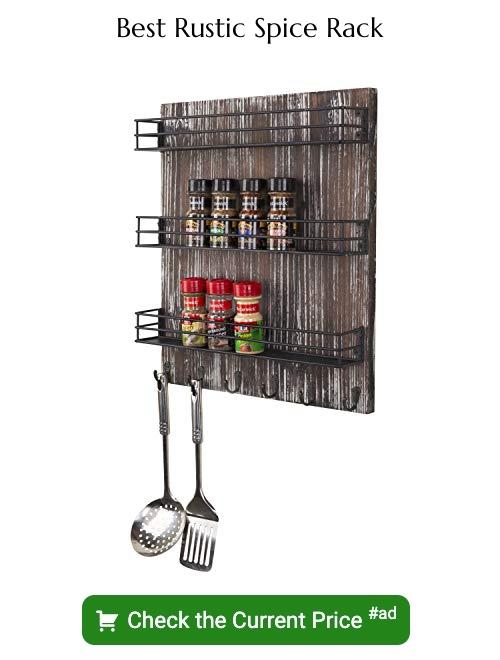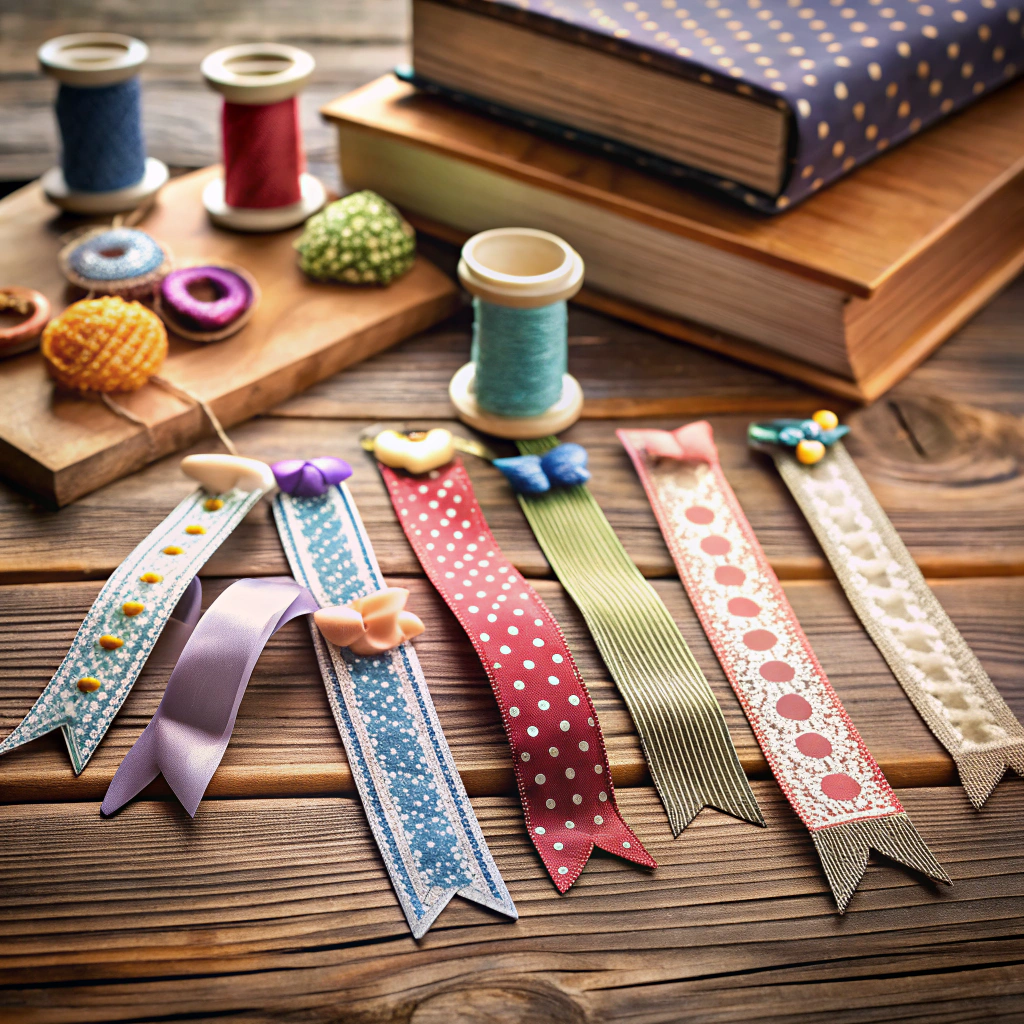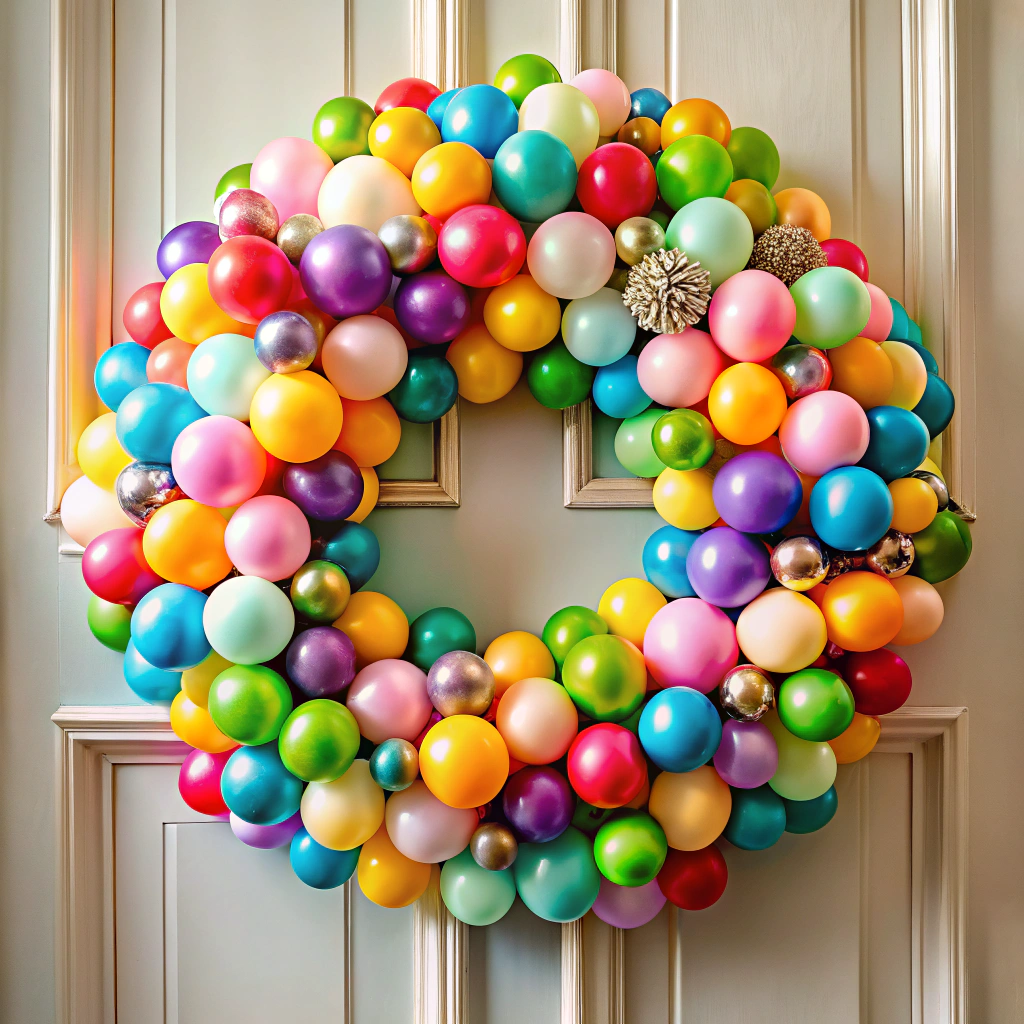Last updated on
Transform your kitchen into a rustic haven with these unique spice rack ideas, because the charm of well-curated, classic decor will never go out of style.
I’ve designed unique illustrations for these ideas. I hope you get inspired!
Spice racks might be common in the kitchen, but you can make it splendid by using different kinds of rack designs that are out of the norm. There are many varieties out there, some of which can complement your kitchen interior. Rustic racks are our favorites.
We’re talking about great space savers (that aren’t very wide) and unique-looking racks made for fun that even kids would enjoy using.
So what are you waiting for? Read on about the rustic spice rack ideas we’ve discovered in this post for your inspiration. Check these out!
Repurposed Pallet Wood Spice Rack
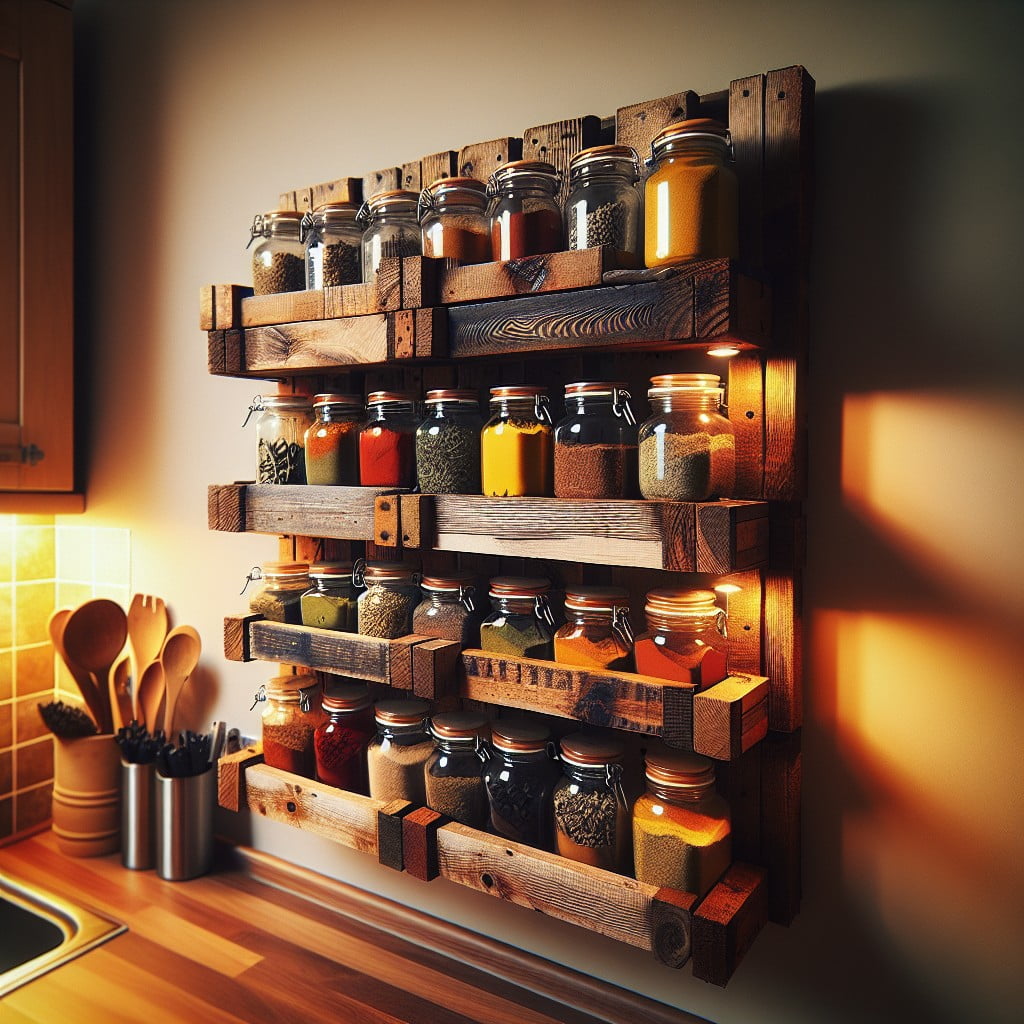
For this charming piece, start by seeking out an old pallet. Ideally, choose one with naturally weathered wood for an extra dose of rustic charm.
Disassemble your pallet, paying close attention to remove all nails and staples.
Now, plan out your shelves, measuring carefully to account for different heights of spice bottles.
You’ll want to sand the wood to a smooth finish for a professional look. This step helps prevent any sharp bits and eases the application of sealant or paint, should you wish to change the natural color of the wood.
Assemble the rack by attaching the shelves to the main piece of pallet wood. Opt for sturdy screws that can withstand the weight of the spice bottles.
To give it a final touch, apply a coat of protective sealant to improve the rack’s longevity.
Now, you have a rustic spice rack, ready to hang near the stove or the kitchen counter for easy access while cooking.
Remember, the key to a successful DIY project is patience and precision.
Don’t rush the assembly stage, and make sure everything fits perfectly before placing your spice bottles.
Tin Can Wall Mounted Spice Rack
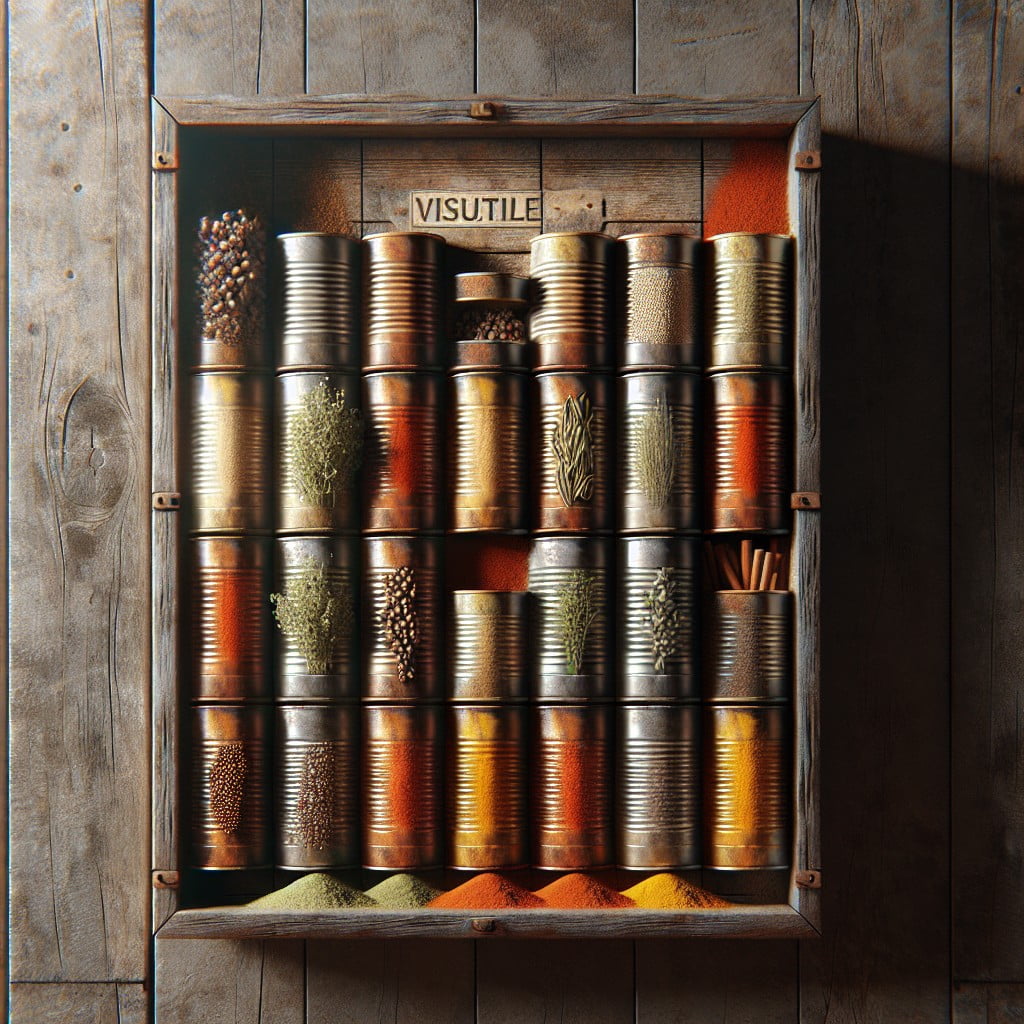
Embracing a wonderfully innovative approach, you can transform a normal tin can into an unconventional wall-mounted solution. This idea not only saves counter space but also introduces a unique industrial edge to your kitchen decor.
1. Materials: Collect some empty tin cans— clean and remove any labels. Ensure they are free from sharp edges for safety.
2. Mounting: Depending on your wall material, determine the best method to affix the cans, be it through strong adhesive, screws, or Command strips.
3. Layout: Before mounting, decide on the layout. Arrange the cans in vertical or horizontal rows, or even a creative pattern, based on your preferences and space availability.
4. Decoration: Add a rustic touch by wrapping jute or twine around the body of the cans, or paint them in earthy tones.
5. Labeling: Clearly mark each can with the spice it contains. This could be done with small hangtags, chalk paint, or printed labels.
Remember, depending on the size of the cans, this rack can be used to store not just spices but also larger items like olive oil bottles or cooking utensils.
Rustic Ladder Spice Shelf
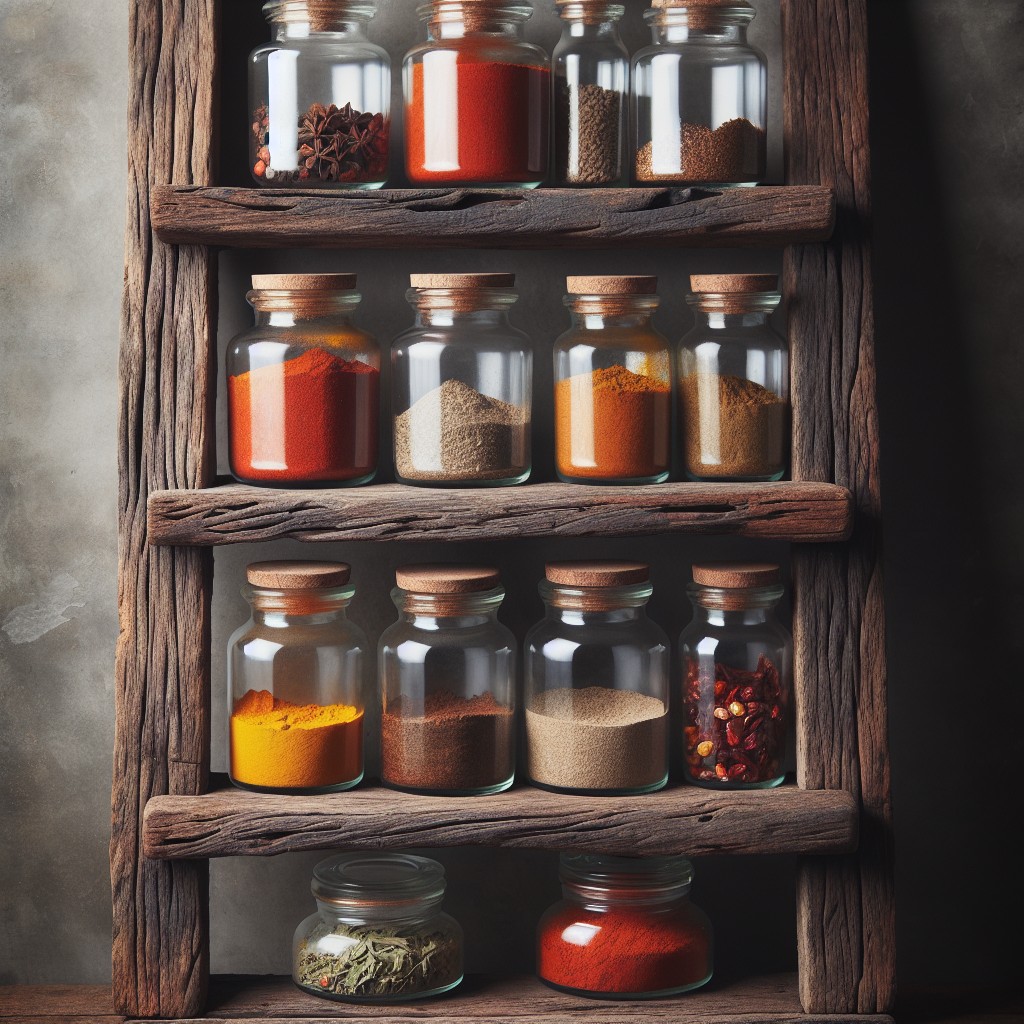
Adopting unique forms of storage not only brings convenience into your kitchen but also adds a touch of elegance. What better way to achieve this than to use an old ladder? Yes, you read that right. An old ladder can be transformed into a functional and aesthetic spice rack.
Begin by leaning your ladder against a kitchen wall, ensuring that it is safe and secure. It can be painted to match your kitchen’s color theme or left in its natural rustic state for an authentic vintage look. The steps of the ladder serve as the perfect shelves for your spices and herbs.
For maximum efficiency, arrange the spices on each rung according to frequency of use or alphabetically. Small wooden or metal boxes can be used to further organize your spices and prevent any from falling off. The ladder’s side rails can also act as extra storage for hanging utensils.
This rustic ladder spice shelf encapsulates simplicity, inventiveness, and utility all in one, making it an excellent addition to your kitchen space.
Barn Door Mini Spice Rack
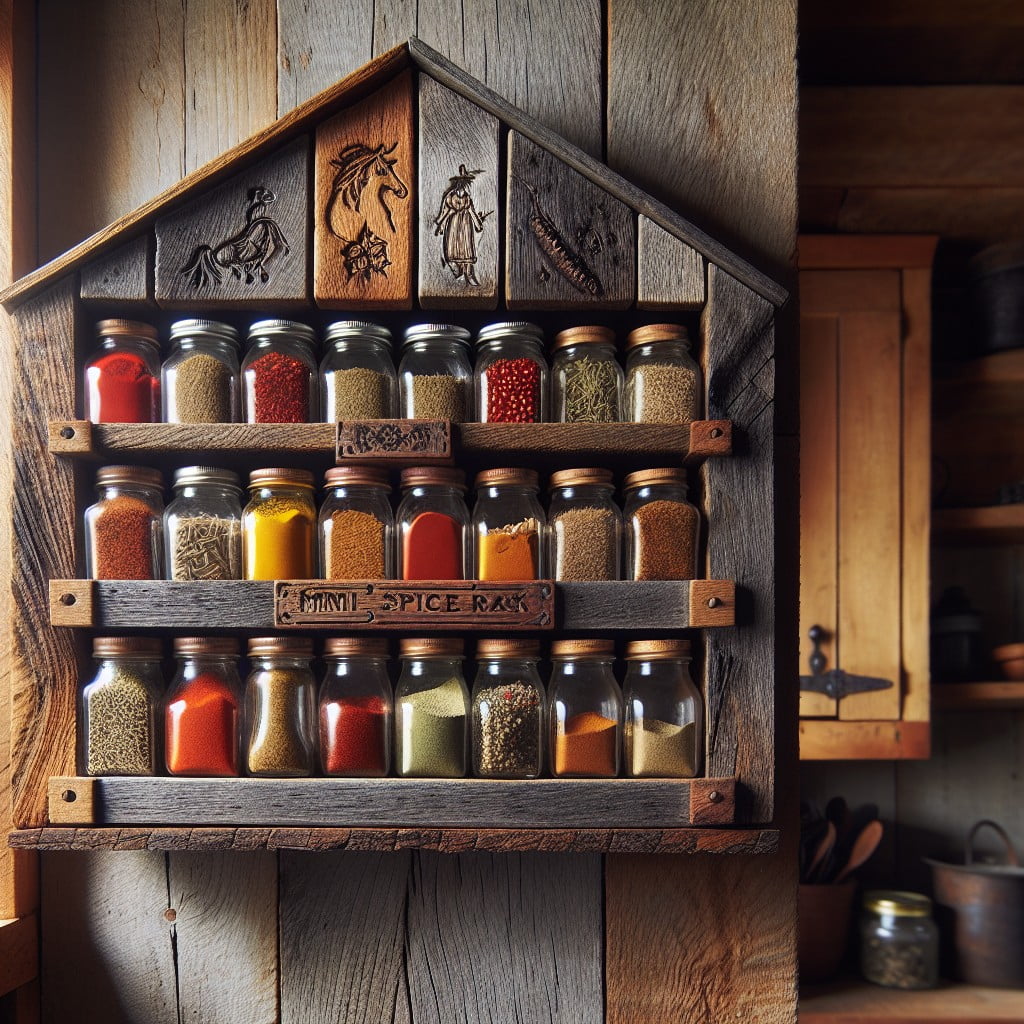
Crafting a Barn Door Mini Spice Rack can be a fun and functional DIY project. Its charming vibe echoes countryside living, echoing functionality and charm in your kitchen. Let’s go over some key considerations:
1. Material: Owing to their distinct appearance, authentic barn wood or reclaimed wood is ideal. Weathered look adds to the rustic appeal. However, you can also use new lumber and age it artificially with paint.
2. Size: Keep it mini! These are typically compact, making them perfect for smaller kitchens or cooking spaces. Size it to match the number of spice jars you own.
3. Design: It should resemble a barn door. This includes details like miniature cross-beams and rustic hardware. Many even incorporate sliding mechanisms for added authenticity.
4. Storage: Plan for the spice bottles. Shelves or built-in cubbies evenly spaced can accommodate the spices neatly.
5. Mounting: Ensure sturdy support, especially if heavy jars are in the plan. Mount it securely to a solid wall or cabinet side.
6. Finishing: Enhance the rustic look with faded paint, a touch of sanding, or clear varnish to retain the wood’s natural look.
By following these guidelines, you’ll craft a spice rack that is not only practical but also adds a touch of country charm to your kitchen.
Vintage Mason Jar Spice Organizer
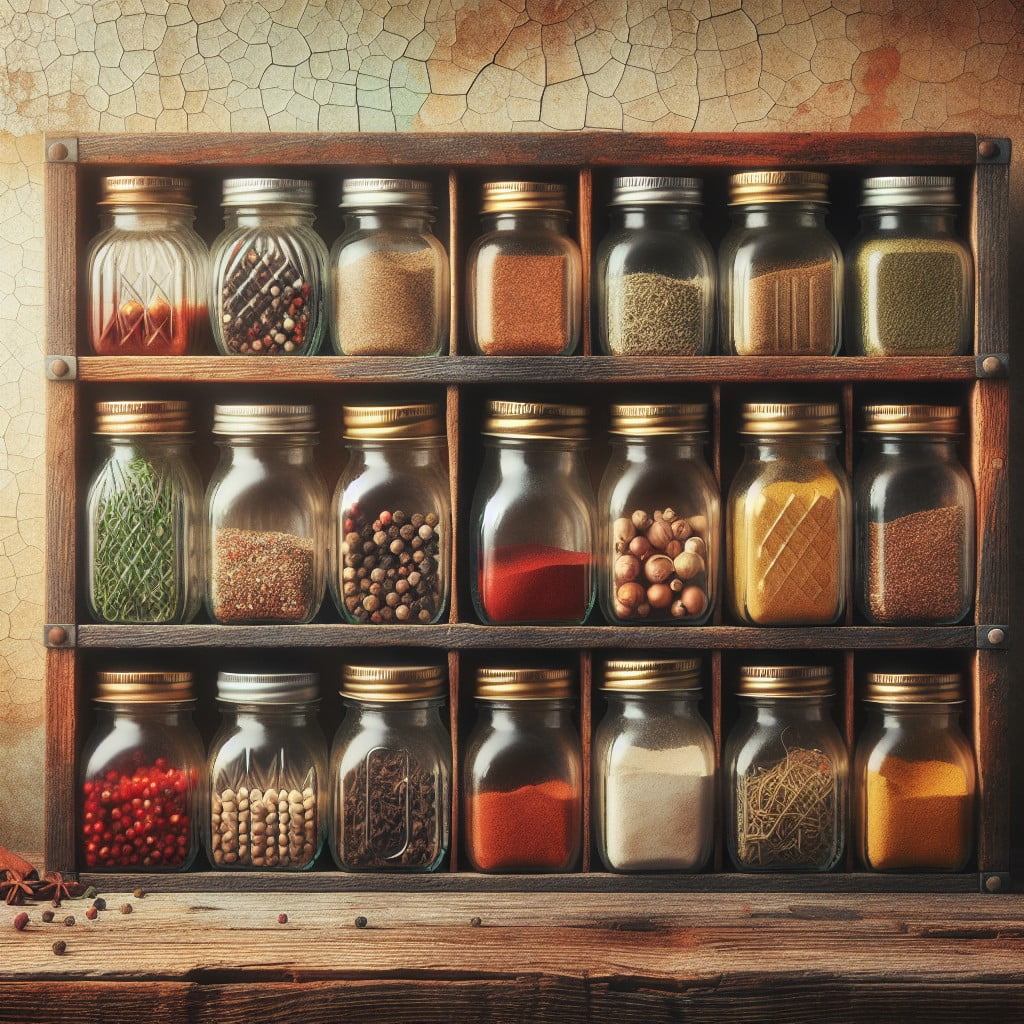
Harnessing the classic charm and practicality of much-beloved mason jars, this unique spice organizing solution adds a whimsical touch to rustic kitchens. Here’s how to create an eye-catching display without sacrificing usability:
1. Select jars: Esthetically pleasing and airtight, traditional quart, pint, or smaller jars are ideal for this setup. Their clear construction also makes identifying spices a breeze.
2. Arrange by use: Frequented spices should sit comfortably in front for easy access. Lesser-used spices can inhabit the rear or upper portions of the rack.
3. Personalize labels: From chalkboard paint to stylish premade tags, labeling options are aplenty. Choose a method that matches your kitchen’s overall aesthetic best.
4. Opt for a sturdy rack: With the weight of glass jars, prioritizing robust materials for your rack like sturdy wood or metal is essential.
Remember, functionality is as important as looks. Crafting an organizer that caters to your specific cooking needs will guarantee long-term satisfaction with your vintage mason jar spice organizer.
Log Cabin Style Spice Rack
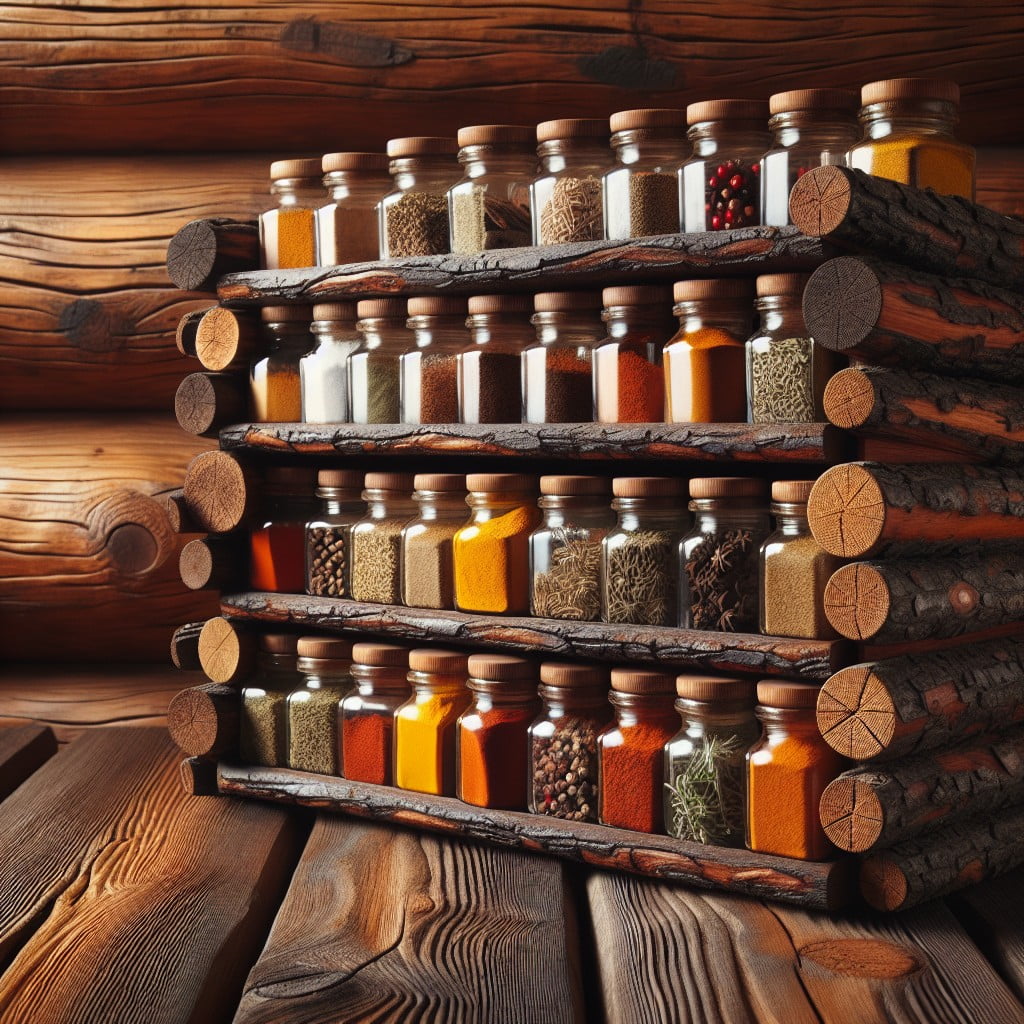
Embodying a quintessential log cabin essence, crafting such a spice rack becomes an idyllic endeavor. Here are a few key notes to reinforce this rustic charm.
- Material: Utilize unprocessed logs or reclaimed wood, keeping the natural bark intact. It’s rough, rugged, and captures the wilderness spirit perfectly.
- Simplicity: The design should be straightforward, mimicking the minimalistic construction of an actual log cabin. For example, a small three-shelf design can comfortably hold a variety of spices.
- Finish: To preserve the organic, raw aesthetics, opt for clear, matt finish, wood sealants. This would protect the wood without compromising its authentic appearance.
- Fixtures: To hang your spice rack, consider using cast iron or tarnished metal brackets. The aged, rustic metal would augment your woodland theme distinctively.
- Accessories: Incorporate small elements like mini wooden pegs to hang dried herbs, adding functionality, and reinforcing the rustic appeal.
Wrought Iron and Wood Spice Holder
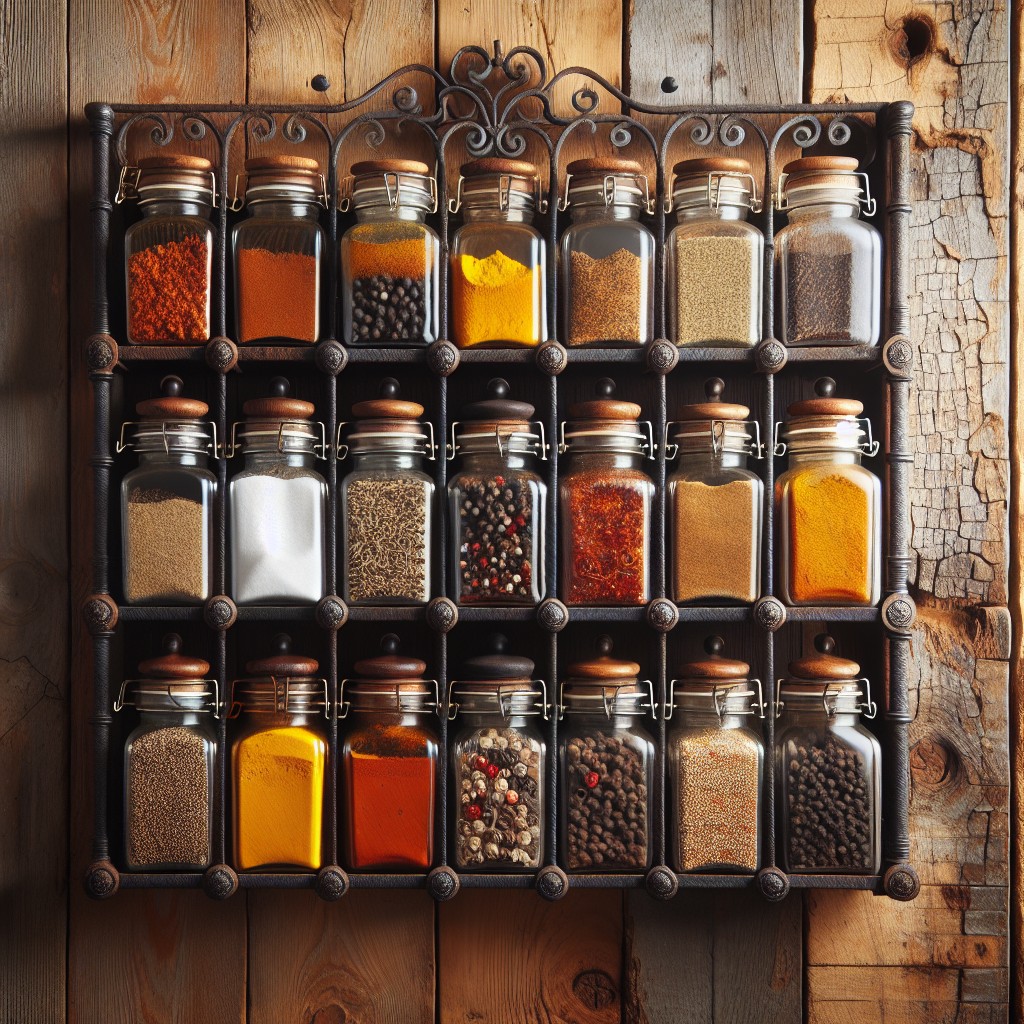
Combining the sturdy endurance of wrought iron with the natural warmth of wood creates an attractive storage unit that complements rustic aesthetics perfectly. Here are some key points to consider:
1. Design selection: Choose between traditional, fancy scrollwork or a clean linear, modern look according to the existing décor.
2. Wood type: Hardwoods like oak or teak offer a chic contrast with iron, while pine provides a more country-style feel.
3. Construction method: Bolting wooden planks onto an iron frame provides added stability compared to simply gluing.
4. Finishing touches: Consider varnishing or staining the wood for enhanced durability and added aesthetics.
5. Installation: Determine whether wall mounting or counter-top positioning is the best fit based on kitchen space and user preference.
6. Size determination: Consider a design that supports common spice jar shapes and sizes.
This form of spice storage not only serves a practical purpose but also adds a rustic charm to the kitchen setting. Equally important, wrought iron and wood both possess significant durability, ensuring the spice rack serves its purpose for years to come without showing signs of wear and tear.
Antique Drawer Spice Shelf
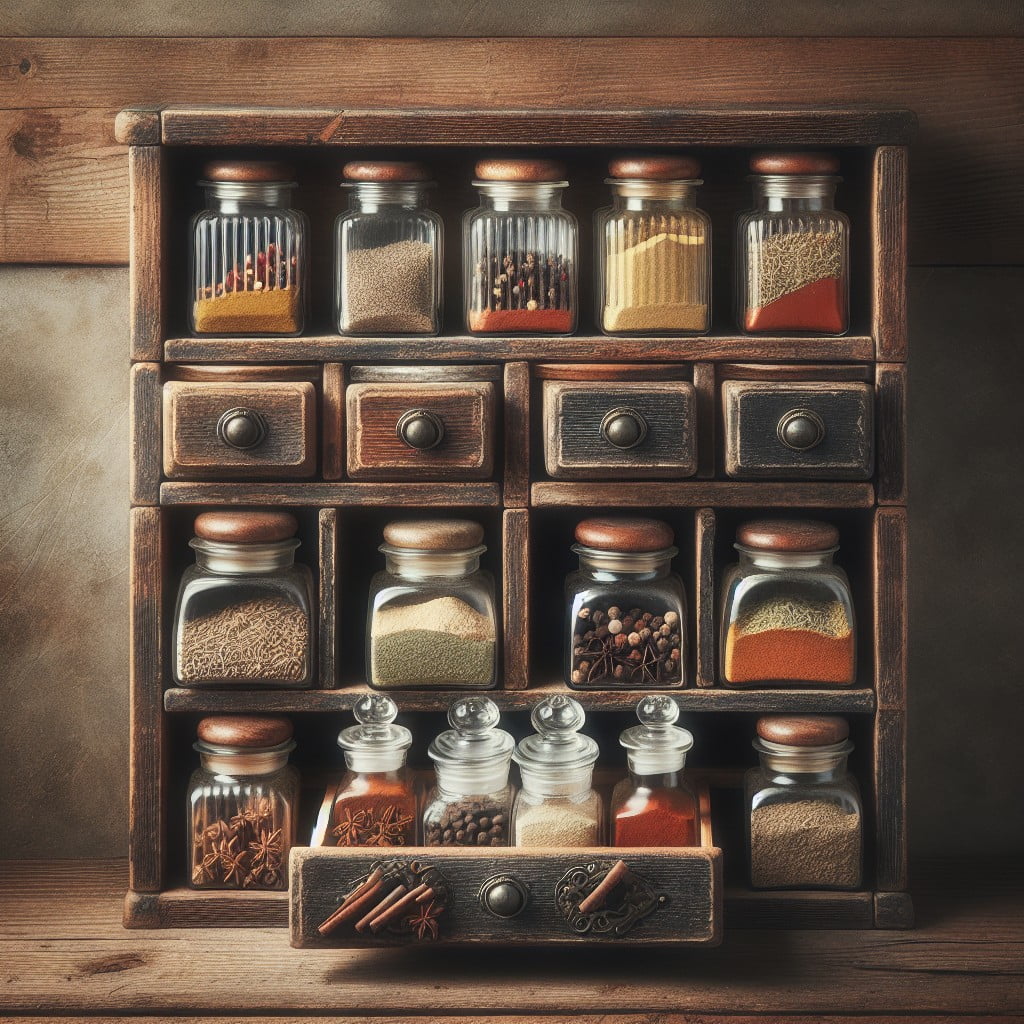
To create an Antique Drawer Spice Shelf, you’ll need an old piece of furniture with small drawers, like a vintage sewing table or a library card catalog. These pieces are not only aesthetically pleasing but offer practical and easily accessible storage. Sanded down and left with a rough finish, the drawer retains its original rustic charm.
The drawer dividers work perfectly for organizing spices.
Here are some tips to further enhance this rustic creation:
- Consider using drawer labels for easy identification of spices. Vintage-style labels add an extra touch of authenticity to the setup.
- Depending on the height of your drawers, you may wish to lay your spice jars flat or stand them upright. Test out different organization methods to see which works best for your needs and space.
- If the drawer doesn’t come with built-in dividers, you can create your own using small pieces of wood. This allows you to customize the slots based on jar sizes.
- To accommodate more spices, you may also consider adding shelves above or below the drawer.
- Maintain the rustic appearance of your drawer spice shelf by polishing it with beeswax or oil, rather than a glossy varnish.
Keep in mind, this may take some time to set up, but the end result is an attractive, functional spice storage that enhances your kitchen’s rustic charm.
Rustic Spice Rack With Hooks for Utensils
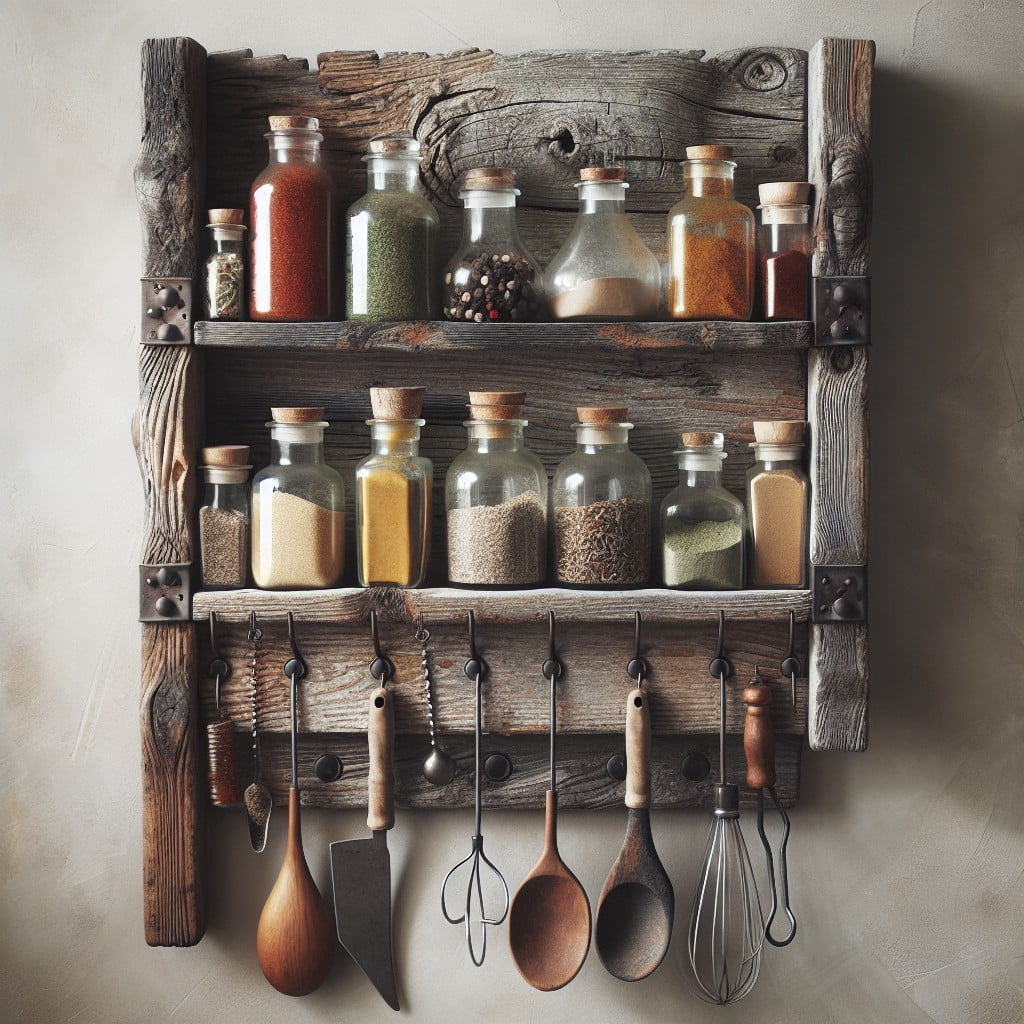
Incorporating a hooks system in your spice rack design adds both functionality and charm. This concept utilizes space wisely, keeping essential utensils at arm’s reach while cooking.
Select a sturdy wood such as oak or pine and allow its natural rustic finish to shine through for an authentic look. You can distress the wood for added effect.
Hanging elements often include spoons, measuring cups or small skillets, which brings a visually pleasing mix of textures to your kitchen. This design element is both practical for daily use and delightful for the onlooker. It’s a perfect blend of organization and rustic style.
However, ensure strong hooks alongside the sturdiness of the rack itself, as the weight of utensils can be substantial.
Accomplishing this project can be a fun DIY task. All needed are planks of wood, sturdy hooks, a touch of varnish, and an array of your favorite spices to create your functional, rustic spice rack with hooks for utensils.
Rustic Wine Crate Spice Unit
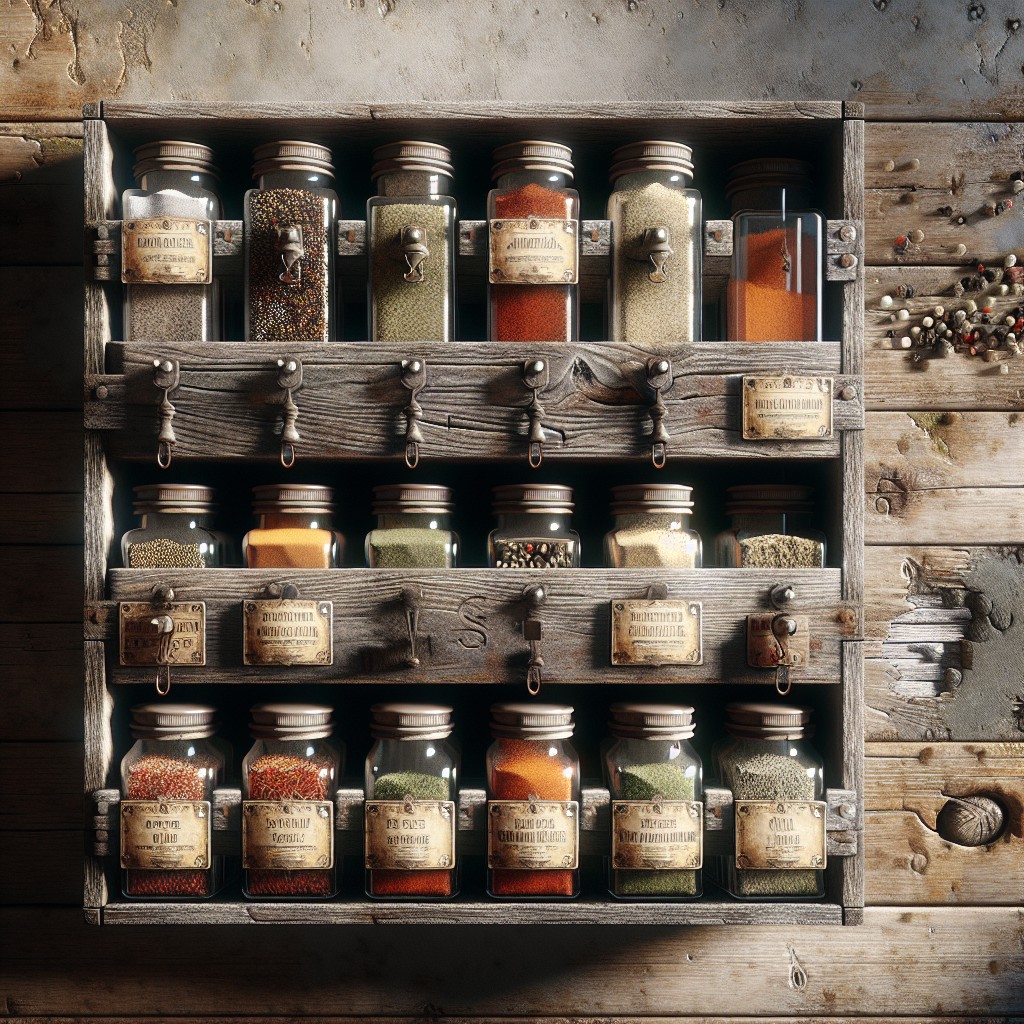
Crafted from repurposed wine crates, this space-saving solution provides a stunning hit of rustic charm to any kitchen decor. Its sturdiness and wooden texture add an old-world feel while serving a practical purpose of organizing your spices.
1. Make Sure to Treat the Wood: To keep the unit looking its best for years to come, apply a coat of sealant to the wood. This will enhance the natural grain and protect it from moisture damage.
2. Shelf Spacing: Depending on the size of your spice jars, adjust the height between the shelves. This ensures an easy and comfortable retrieval of the spices while cooking.
3. Label the Spices: Use rustic hand-written tags or print out stylish labels to easily identify the spices inside each jar.
4. Positioning: Position your wine crate spice unit within an arm’s reach of your stove or prep area for most efficiency.
5. Customize It: Personalize your rustic wine crate spice unit by painting or stenciling it to match your kitchen decor.
Remember, the beauty of this design lies in its simplicity and authenticity. Each wine crate brings a unique charm that imparts a warmth and rusticity, making your spice collection not just functional, but also a sight to admire.
Galvanized Metal Spice Organizer
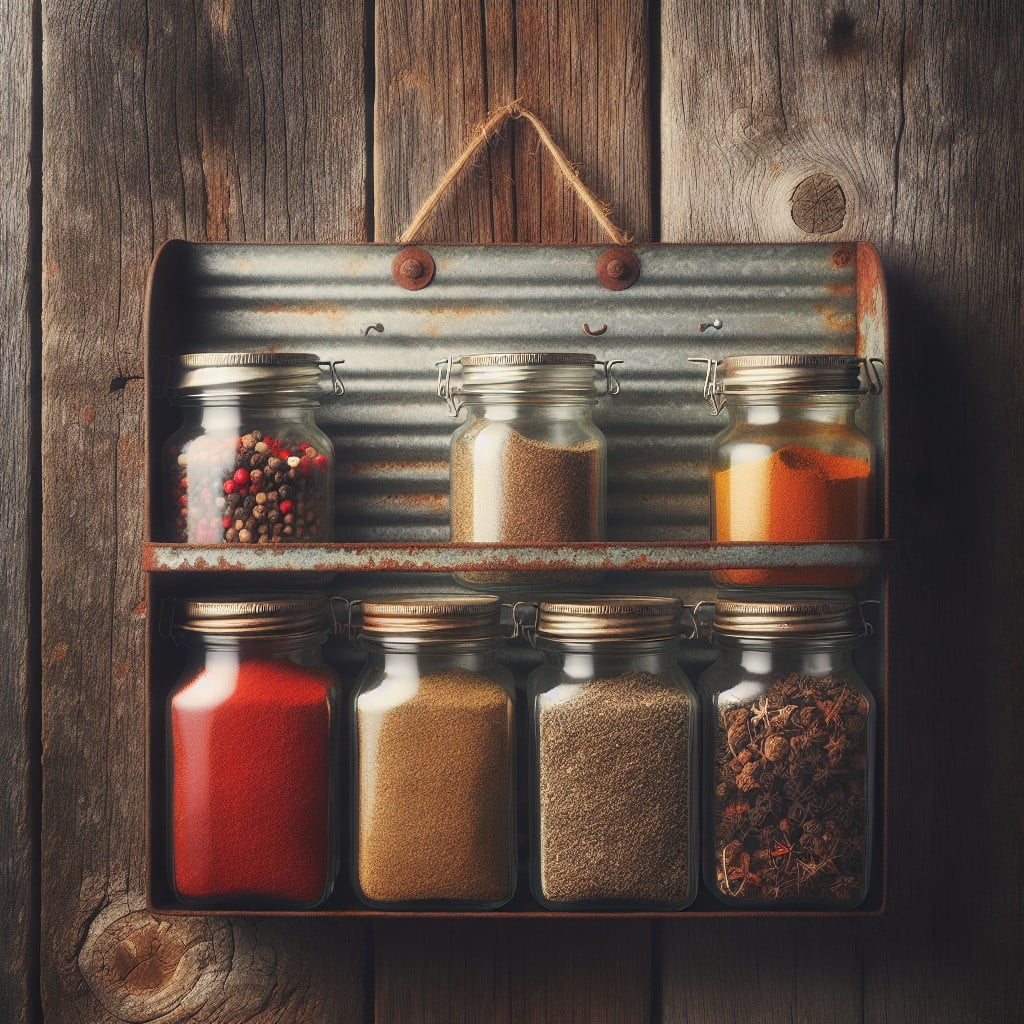
A galvanized metal spice rack is sure to add an air of industrial chic to your kitchen while keeping your spices handy. Start by investing in a multi-tier galvanized metal organizer. Opt for one that suits your kitchen size and spice quantity. Remember, they come in various shapes and sizes. Make sure it has ample room to allow for the storage of different spice containers.
Its raw and rugged aesthetic is great for a rustic look. The main advantage of choosing metal is its durability. Unaffected by moisture and temperature changes, it’s perfect for any climate.
You can label your spice containers and place them alphabetically for easy access. Cleaning is quick and trouble-free: it only needs a damp cloth wipe down. Also, securing it is easy – you can choose to hang it on the wall or place it on the counter. You can enhance its rustic charm by pairing it with a wooden countertop or setting it against a brick wall.
This organizer not only displays spices gracefully but also frees up cabinet space. Its open and accessible design will encourage you to experiment more with your recipes, boosting your creative culinary explorations. The shine of the galvanized metal under your kitchen lights will certainly be a show-stopping update.
Hanging Herb Garden Spice Rack
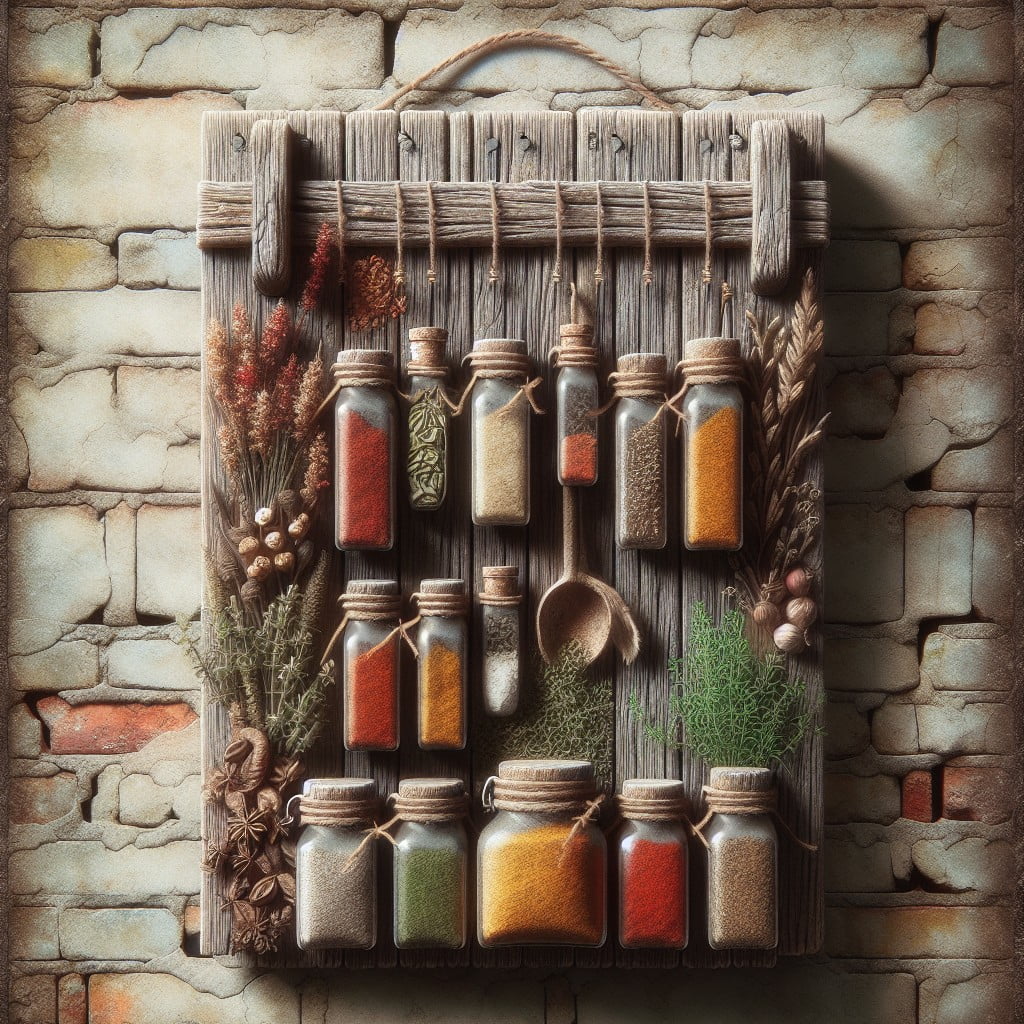
A hanging herb garden spice rack adds not only convenience in the kitchen but also infuses your space with bursts of color and fresh aromas. Here are a few tips to nail this idea:
1. Find a Sunny Spot: This rack needs plenty of sunlight. Consider hanging it near a window for ample natural light exposure that your herbs will love.
2. Choose the Right Herbs: Popular choices include basil, thyme, and rosemary. They’re not just culinary stars but also fairly easy to grow indoors.
3. Opt for Lightweight Pots: Hanging planters or repurposed tin cans work great. Make sure they have good drainage to keep your herbs healthy.
4. Ensure Easy Access: Arrange the herbs you use most frequently in lower, easy-to-reach pots.
5. Keep It Small: Don’t overstuff. Give each herb its own small pot for room to grow.
Remember, this isn’t just a spice rack, but a living, edible, decoration. Regular care is needed, but the rewards are two-fold – a rustic decor piece and fresh flavors for your meals.
Burlap Backed Wall Spice Unit
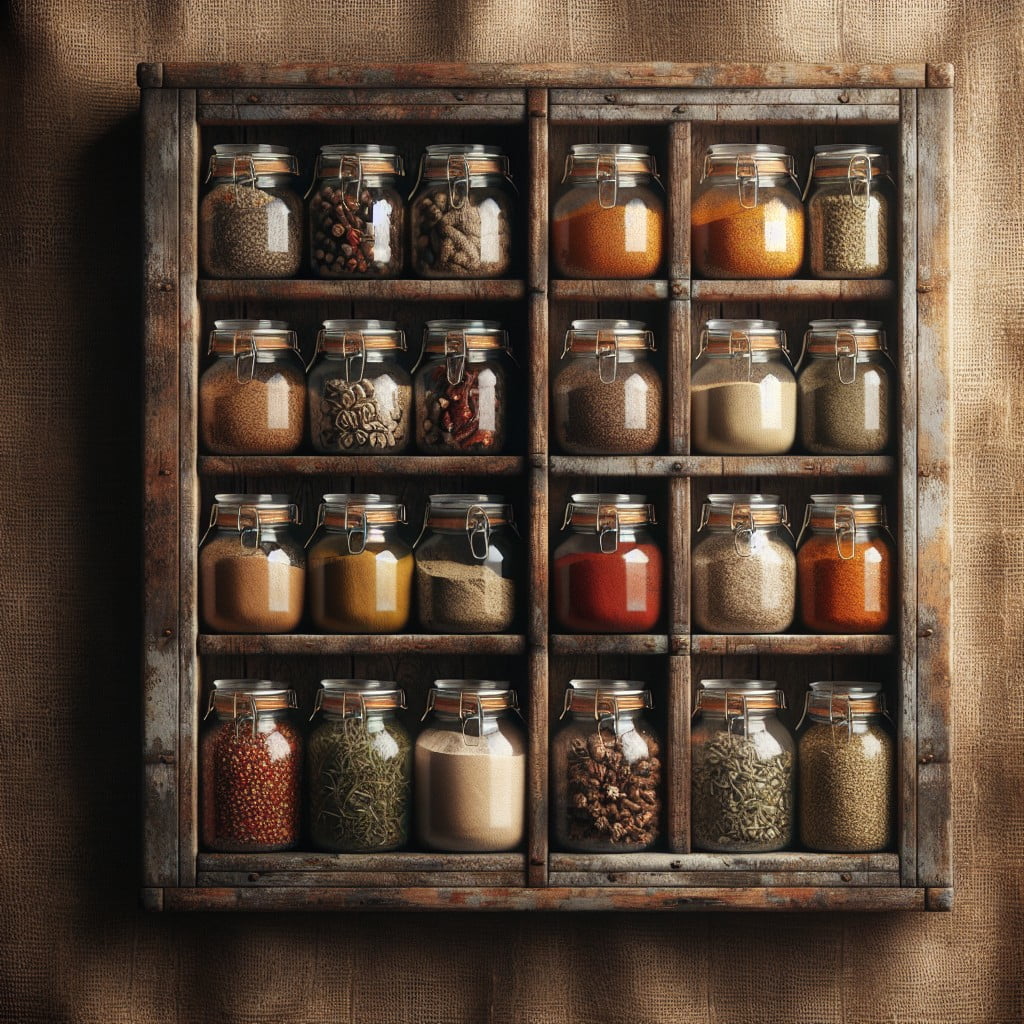
A Burlap Backed Wall Spice Unit offers an ingenious blend of rustic charm and functional design for your kitchen. The play between the rough texture of the burlap and the smooth finish of the wooden shelves creates a visually intriguing contrast.
Constructing this unit can be quite simple. The following are tips to get you started:
- Size: Depending on your spice collection, choose a wooden frame that’s the right size. You want all bottles to be visible and easily accessible.
- Backing: Line the back of the frame with burlap fabric. This lends a distinctive backdrop for your spices, adding warmth to your kitchen decor.
- Shelves: Attach small wooden shelves or spice grippers across the frame. Ensure they’re evenly spaced and securely attached.
- Mounting: Make sure to mount the rack on a wall close to your food preparation area for easy access.
- Extra Touch: Personalize it further by using a glue gun to attach rustic elements like dried flowers or twine.
Remember, this rustic spice rack is not only a great organization tool, but also a fun DIY project and an attractive addition to your decor. It’s a lovely way to display your spices while maintaining that rustic kitchen aesthetic.
Rake Head Spice Holder
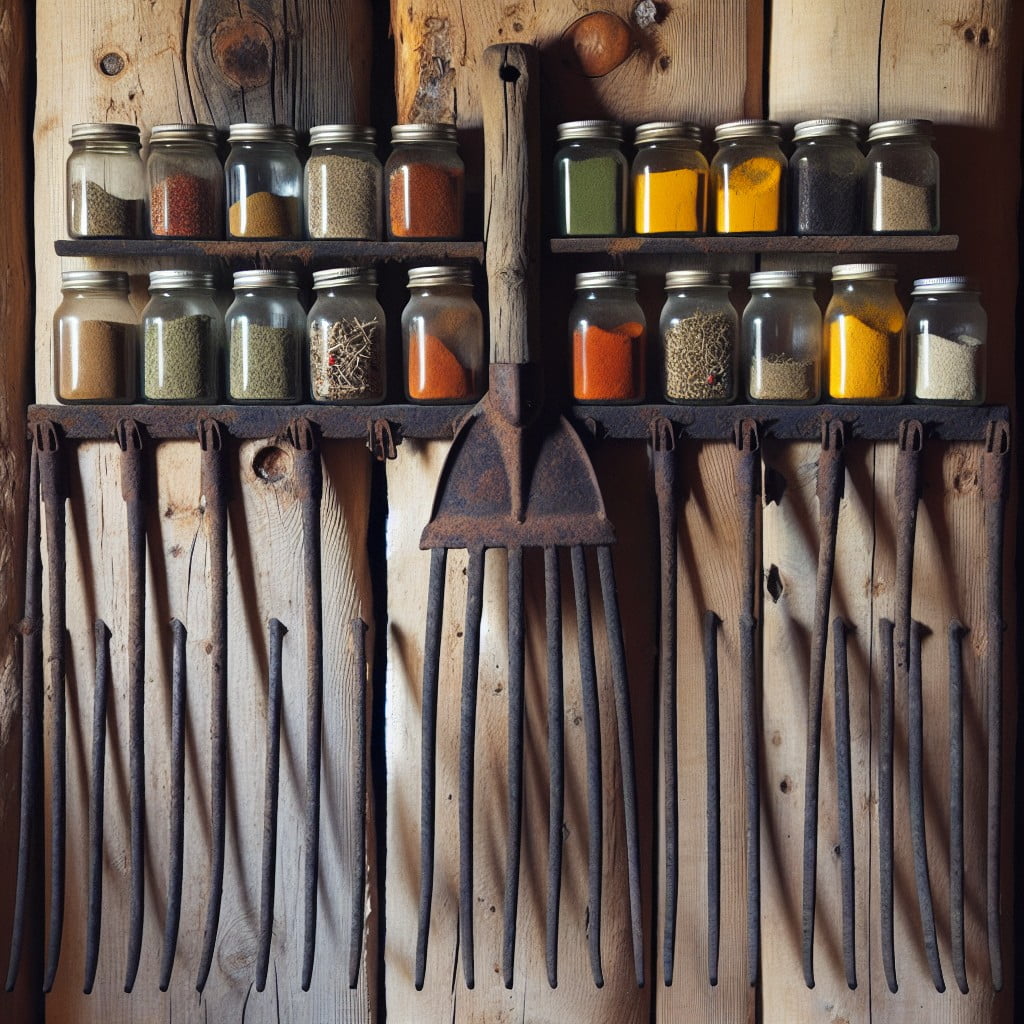
Creating a unique spice rack with an old rake’s head is simple while adding delightful rustic charm to your kitchen space. Known for its prongs ideally spaced, this tool provides a perfect dock for spice jars.
1. Materials: Apart from the rake’s head, you’ll need jars with flat lids, preferably mason jars, and a means to mount the rake, which could be screws or strong adhesive.
2. Preparation: Clean the rake thoroughly to free it of any dirt or rust. Secure any loose prongs.
3. Attachment: Place your rack at a convenient height and mount it securely on the wall.
4. Arrangement: Hang the spice jars by their lids on the prongs. A tip is to secure the lids onto them first, fill the jars later for easier assembly.
5. Adding Personal Touches: Customize your rack by painting the rake or adding labels to your jars.
6. Maintenance: Swapping out spices or cleaning the jars is a breeze. Just unscrew the jar from the lid.
This quirky conversion sustains a rural aesthetic while serving a practical role, making it a great addition for those embracing a country-style kitchen.
Weathered Frame and Shelf Spice Rack
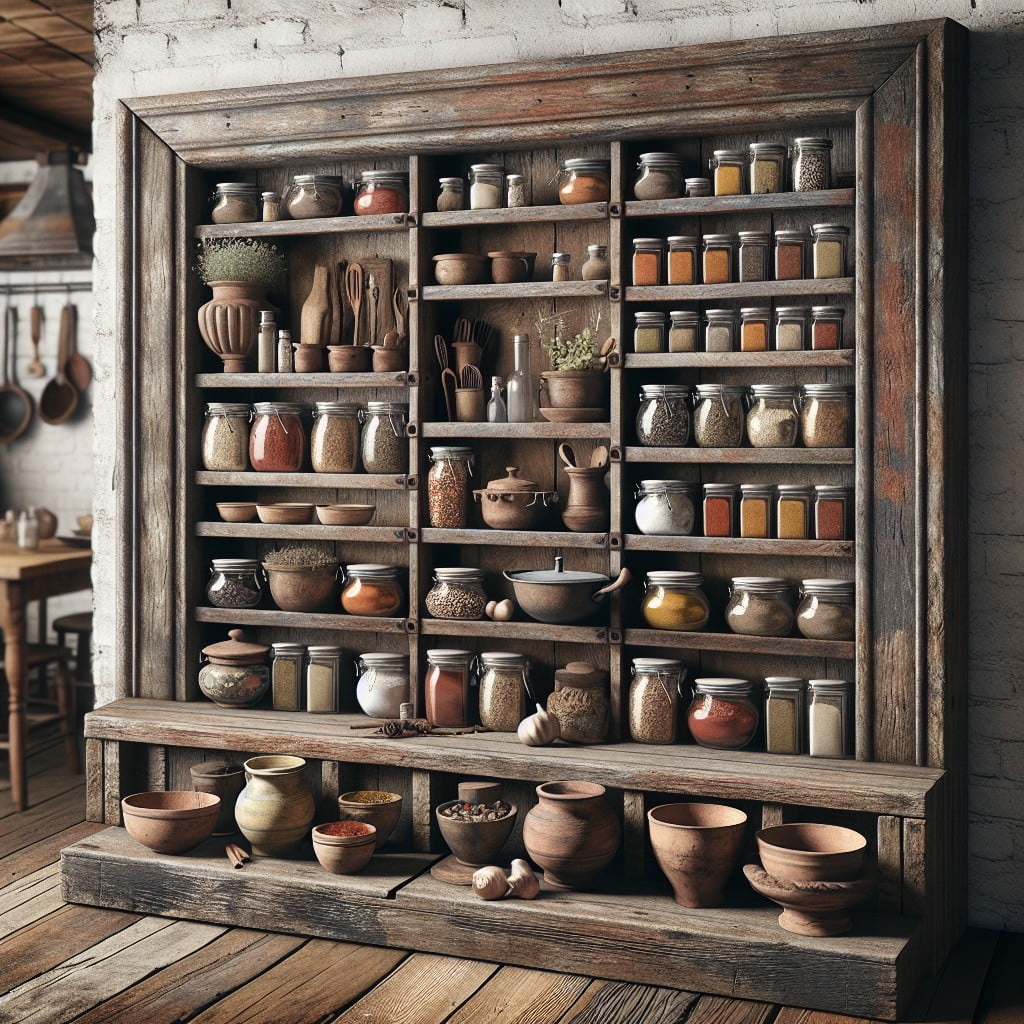
Constructed often with reclaimed wood, this rack offers an appealing, charmingly rough-hewn look. Its distressed surface and antique finish bring an unmistakable rustic charm to your kitchen.
A tutorial in patience and precision, start with measuring the space available and deciding on the size. Next, cut your wooden planks to size – remember, you’ll require two pieces for the sides besides the shelves and the back. Assemble using wood glue and screws for steadfast durability.
Once assembled, it’s time for the artistry. Use sandpaper to roughen the edges and surface, imitating natural deterioration. The more worn-out, the better. Lastly, apply a layer of dark stain followed by lightly brushing on white paint. Always remember, the key is to let the weathered wood shine through for that authentic rustic appeal.
With a few hooks screwed at the bottom, it becomes multifunctional, housing not just your spices but also the cooking utensils. Every piece, every nick in the wood tells a story adding depth and character to your kitchen scenery.
Stone and Wood Spice Holder
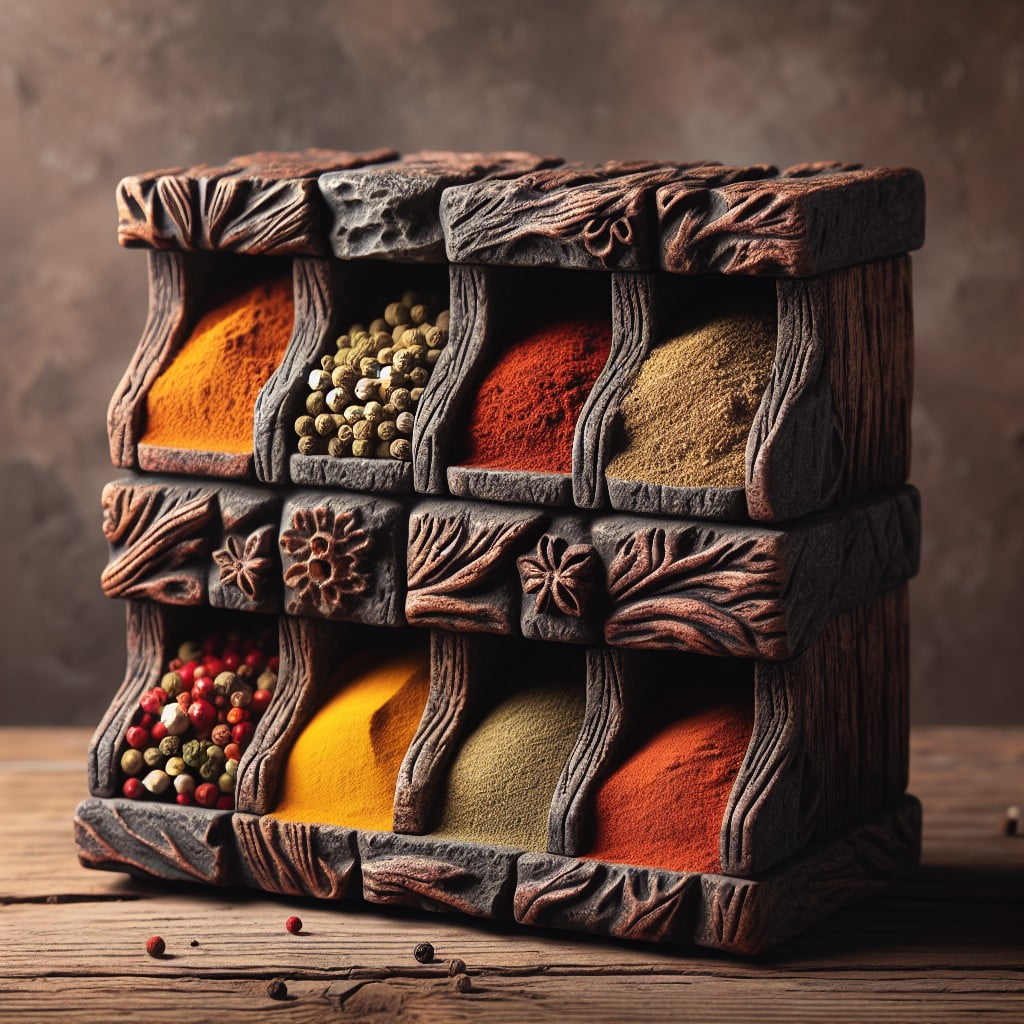
Combining nature’s elements can create a one-of-a-kind rustic spice rack. Stone and wood together embody timeless charm, audacious strength, and rustic sophistication. This design utilizes a smooth stone slab as the base, providing ample support while serving as a statement piece.
1. Select: Begin by selecting a flat stone slab and a piece of wood with a texture and coloring you find appealing. Make sure they’re proportional to your spice collection.
2. Design: Cut the wood into shelves that fit your stone slab. Ensure it’s wide enough to house your spice jars and plan for 2-3 shelves, depending on the stone’s size.
3. Install: Attach the wooden shelves to the stone base using an industrial-strength adhesive. Be sure it’s designed for both stone and wood.
4. Adapt: Depending on the size of your stone, you can place this piece on the counter, mount on the wall, or set within an open cabinet.
5. Arrange: Organize your spices, and enjoy the aesthetic and functional space you have created.
Remember, the hallmark to this design lies in its raw simplicity. Let the natural grains, textures, and colors of your chosen materials become the spotlight of your rustic spice rack. It’s not just storage – it’s art.
Spice Bottles in Wire Baskets Rack
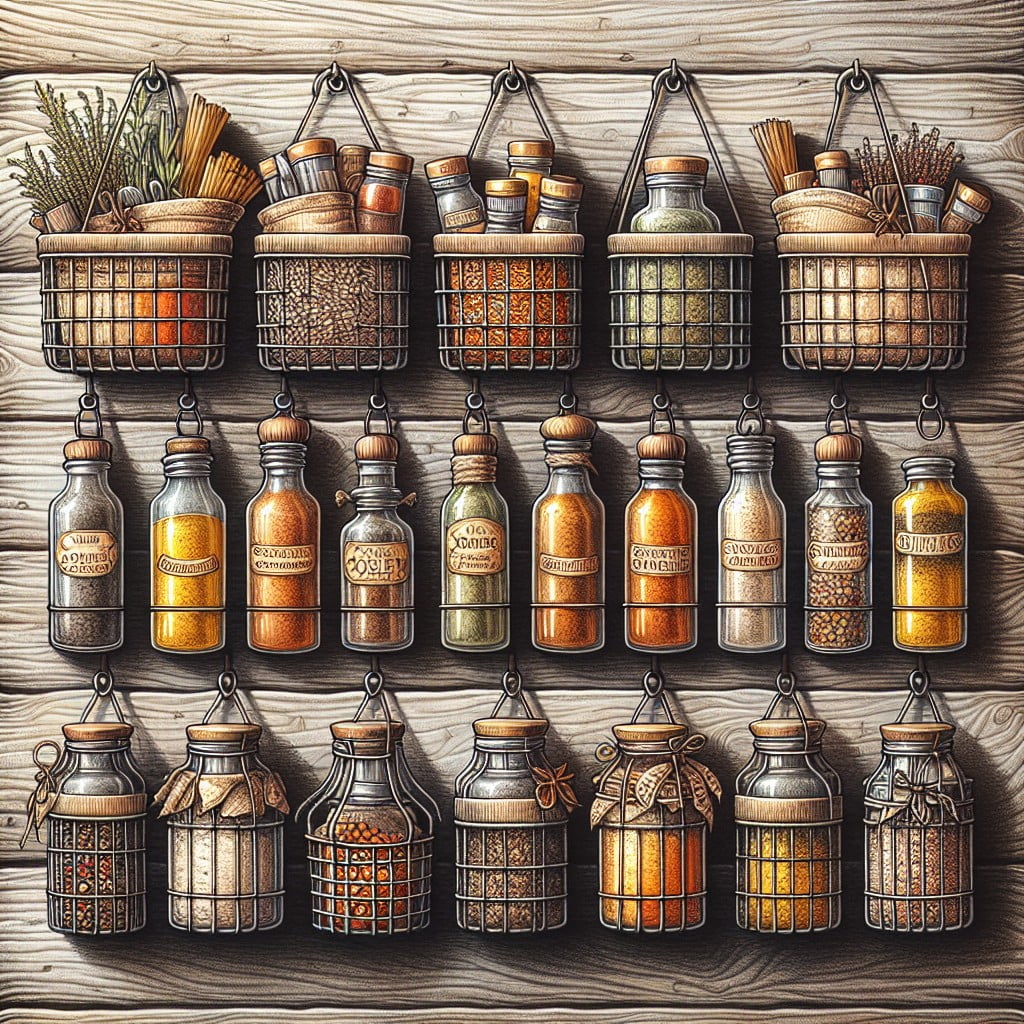
To create this timeless, rustic rack, you’ll need wire baskets of various sizes that suit your storage needs. They offer easy visibility and access to your spices. Opt for farm-style, egg, or vintage wire baskets for an extra rustic feel.
Mount these on an open wall section in your kitchen, but ensure the wall can support the weight of the baskets and spice bottles. Your installation process will include positioning the baskets at alternating heights to give a visually interesting set-up and to allow sufficient space for different-sized bottles.
Ensure the opening of the baskets faces outwards for easy access to your spices. To personalize, you can add name tags to your baskets or label each spice bottle. However, remember to place your most frequently used spices within reachable height.
Now, let’s talk about managing sunlight exposure. Strive to keep your spices away from direct sunlight; consistent exposure can degrade their flavor. This method of spice storage combines aesthetics with functionality, and it’s a perfect choice if you desire a farmhouse rustic kitchen vibe.
Rustic Spice Shelves With Chalk Labels
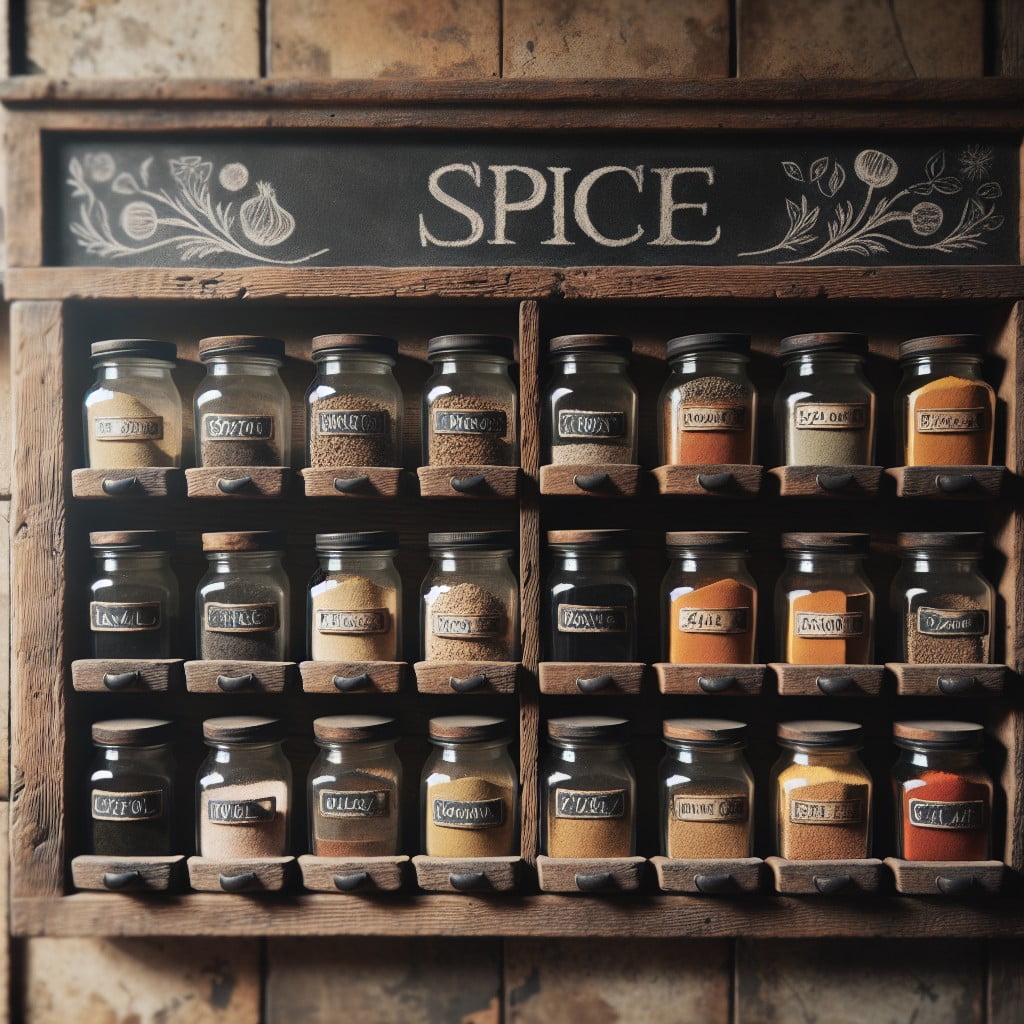
Creating an exciting blend of old-style charm and modern convenience, these shelves offer both aesthetic pleasure and functional organization. Designed from weathered or reclaimed wood, they add a touch of homely rustic appeal to your kitchen. With added chalk labels, quickly identifying and selecting your desired spice becomes a breeze.
Here’s how to make the most out of this design:
- Size: Decide on the size based on your spice collection. You may opt for narrow shelves for smaller collections or wider ones for an extensive range.
Labels: Use traditional chalk or liquid chalk markers for labeling. If handwriting is an issue, consider using stencils for clean, professional-looking letters.
Placement: Install the rack where it’s readily accessible, possibly near the stove or prep area. Make sure it doesn’t obstruct your workspace.
Maintenance: Remember, chalk can dust or fade over time. Regular rewriting may be necessary to keep labels clear and readable.
Style: You can stick with simple white chalk for a classic look, or use colored chalk to match your kitchen’s decor.
Implementing these ideas can help you get the best out of your rustic spice shelves with chalk labels, enhancing both the utility and the style of your kitchen space.
Farmhouse Style Crate Spice Rack
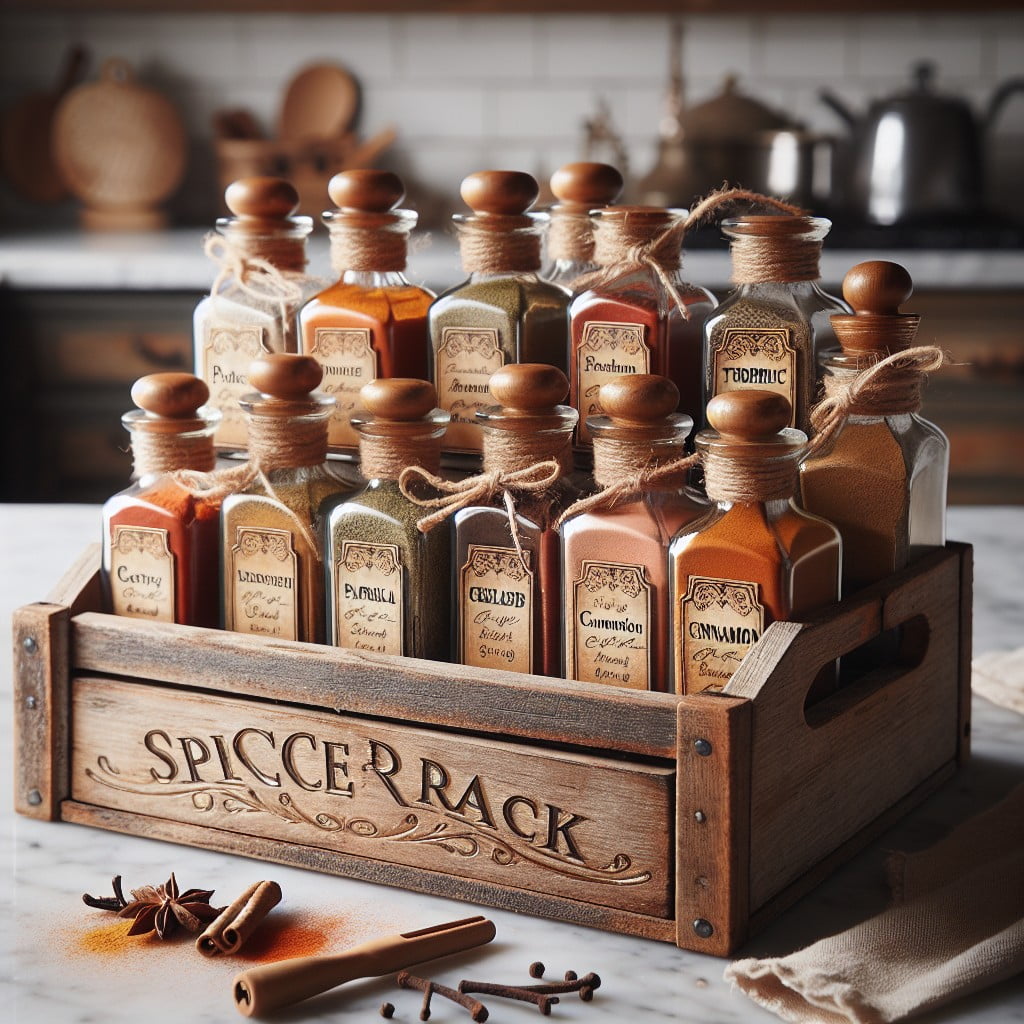
A farmhouse-style crate, reminiscent of days gone by, can be transformed into the perfect rustic spice rack. Textured, weathered wood highlights the charm, providing your kitchen with a touch of vintage appeal. This style is additionally beneficial due to its versatile structure, allowing you to reposition it with ease, should you wish to remodel.
Creating this piece includes the following aspects:
- 1. Selecting the Crate: Choose an old or antiqued wooden crate. This could be discovered at a local thrift store, online, or even an unused one lying around your home. Aim for something sturdy and appropriately sized for your spice collection.
- 2. Preparation: Clean your crate thoroughly. If desired, you may lightly sand it to remove any rough edges.
- 3. Installation: Decide whether you plan to mount the crate or keep it free-standing. If mounting, secure it firmly to your kitchen wall with proper hardware to support the weight of spices.
- 4. Customization: You can add compartments or smaller boxes to segregate different spices. Alternatively, you can label each spice to keep things organized.
Remember, the idea is to embrace imperfections, giving the rack that authentic, lived-in feel. Happy decorating!
Tree Branch Spice Shelf
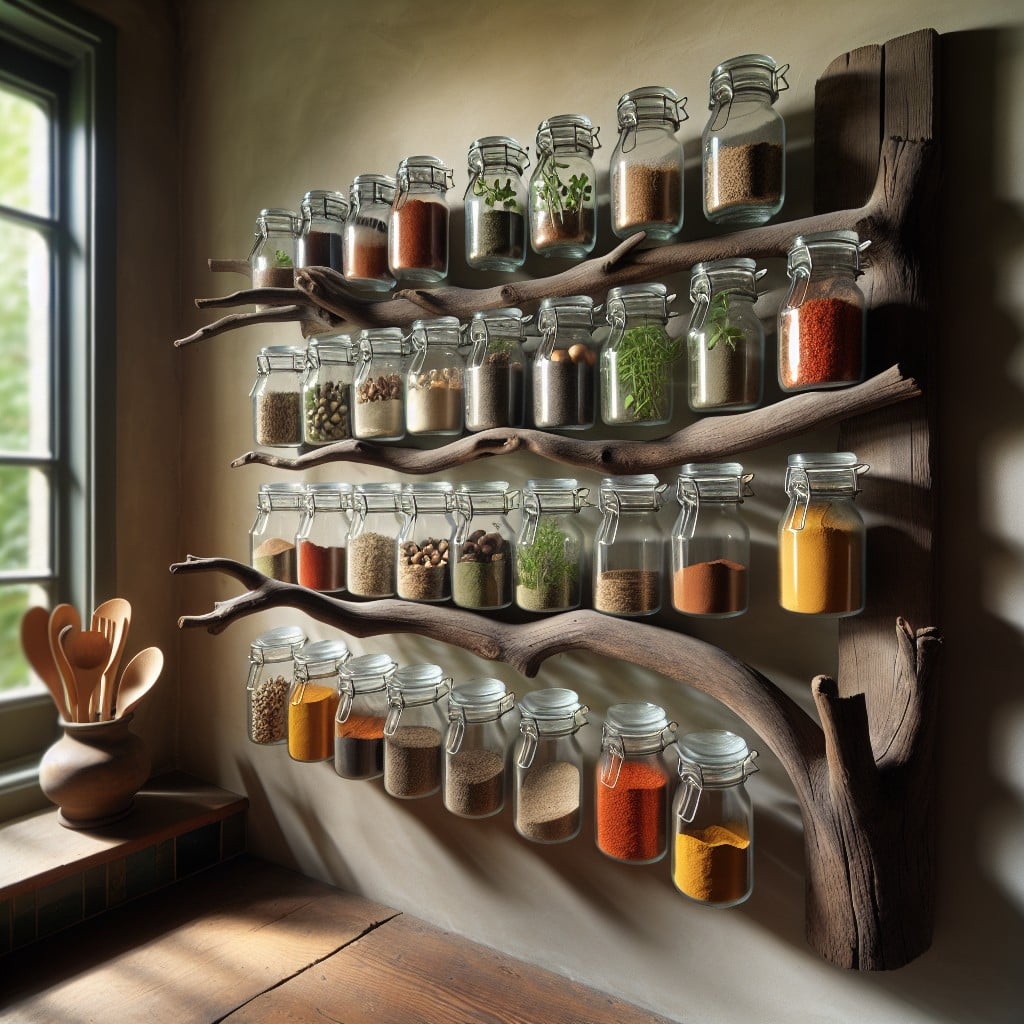
Creating a spice shelf from a tree branch not only adds a unique rustic aesthetic to your kitchen, it’s also an excellent eco-friendly DIY project. You need to first ensure that the branch is sturdy, clean, and thoroughly dried. One standout feature of this design is its simplicity – it can be as minimal or as intricate as you prefer.
You can retain the natural tree bark for an extra rustic effect or peel it off for a sleek finish. Sanding the branch smooth helps to prevent splinters and creates a surface for optional painting or staining.
Mount the branch horizontally on your wall using durable brackets or strong, rustic rope, ensuring it’s secure and level. Spice containers with a magnetic base can be attached directly to a metal strip adhered to the branch or placed in compact wire baskets hooked onto the branch.
Experiment with different types of branches to add variety and texture to your space – from thick oak section to clusters of thin willow wands, the choice adds to your kitchen’s individual charm. Incorporate a tree branch spice shelf into your kitchen for an unexpected, functional, and earthy ambiance.
Reclaimed Wood Wall Spice Storage
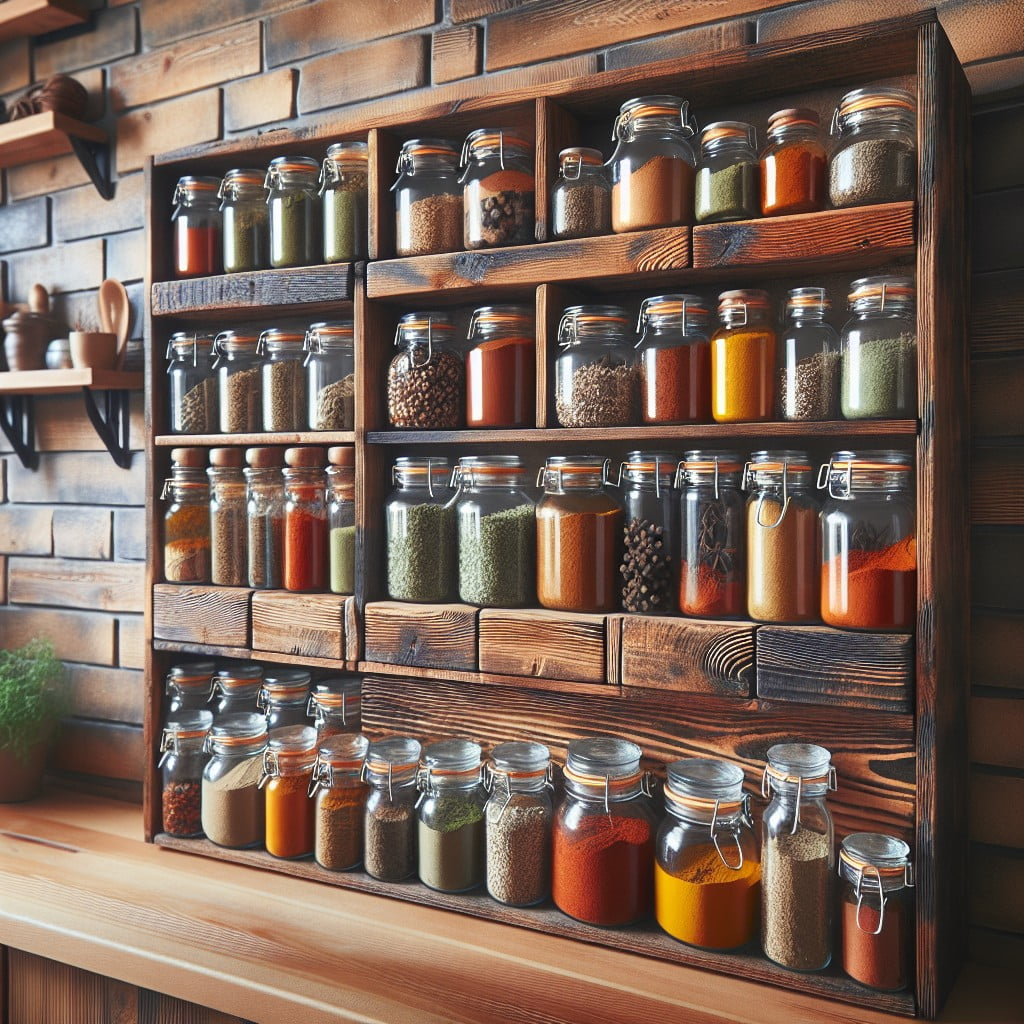
Sourcing reclaimed wood for your wall spice storage not only helps in re-purposing old material which would otherwise be discarded but also offers an environmentally friendly and cost-effective option. This design adds a touch of beautiful vintage aesthetics to your kitchen.
For this project, consider the following points:
- Selection: Choose a piece of wood with a natural, weathered appearance. It should be sturdy and large enough to accommodate your spice jars.
- Cleaning: Ensure to thoroughly clean and sand the wood before use to remove any residual dirt or rough edges.
- Design: Drill holes or fix shelves according to the size of your spice containers. Plan this carefully to optimize space without making it look overcrowded.
- Installation: Install the unit at a location that’s easily accessible, preferentially near your cooking area. This will make it convenient to reach for spices as you cook.
- Customization: Customize with labels or paint to identify your spices and to match the rest of your kitchen décor.
The result would be a unique and functional spice rack that’s a testament to your creativity and DIY skills.
Rustic Wood and Glass Spice Rack
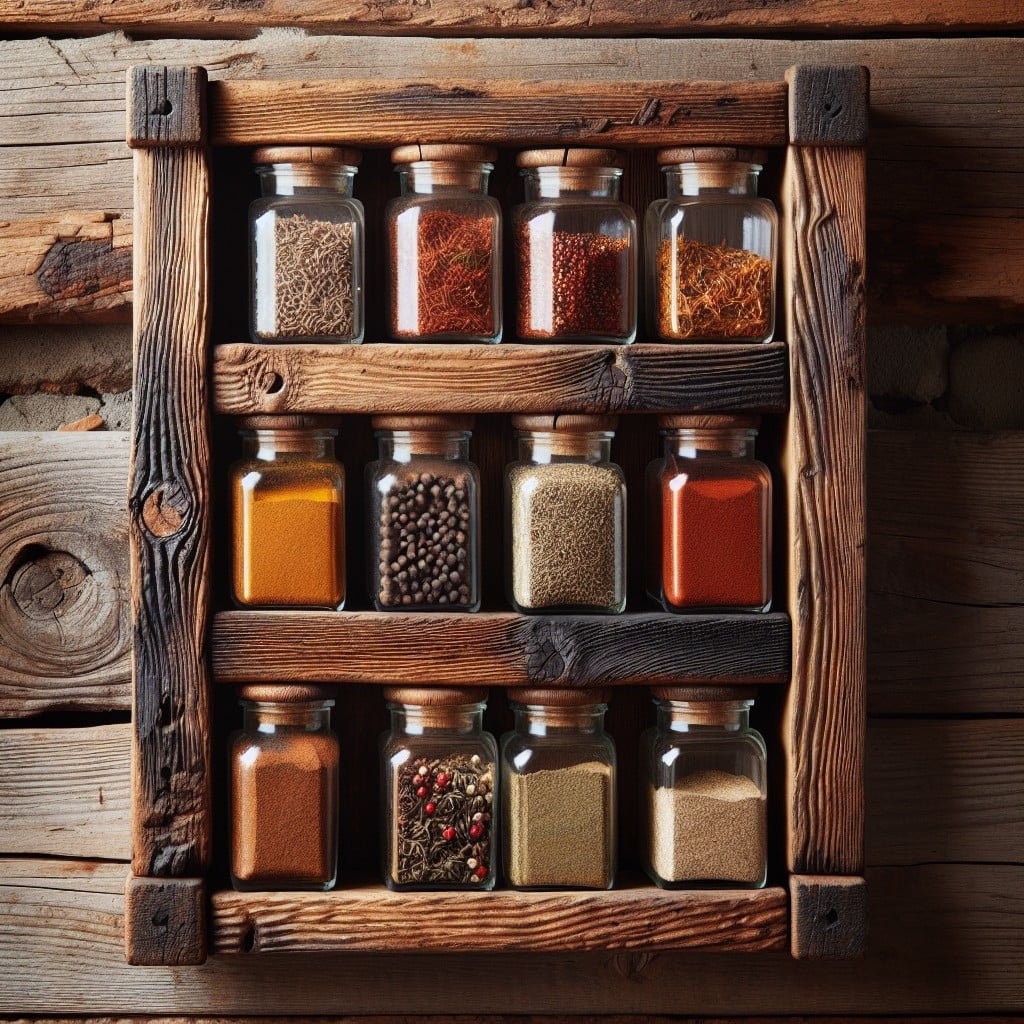
Creating this rack involves using natural wood – pine or oak are excellent choices – with cut-outs for small, clear glass jars. The transparency of the glass not only reveals the vibrant colors of your spices but also allows for easy identification. This pairing brings out a rustic yet sophisticated look, adding character to your kitchen.
To maximize the rack’s utility, consider making it wall-mounted. This will save your kitchen counter space. For a personal touch, shapes like a teapot or fruit can be applied to the wood.
Remember to periodically clean the glass jars to maintain their shine, enhancing the visual appeal of your rack. Use wooden labels or chalkboard stickers for a vintage feel alongside easy spice categorization.
Old Wooden Toolbox Spice Rack
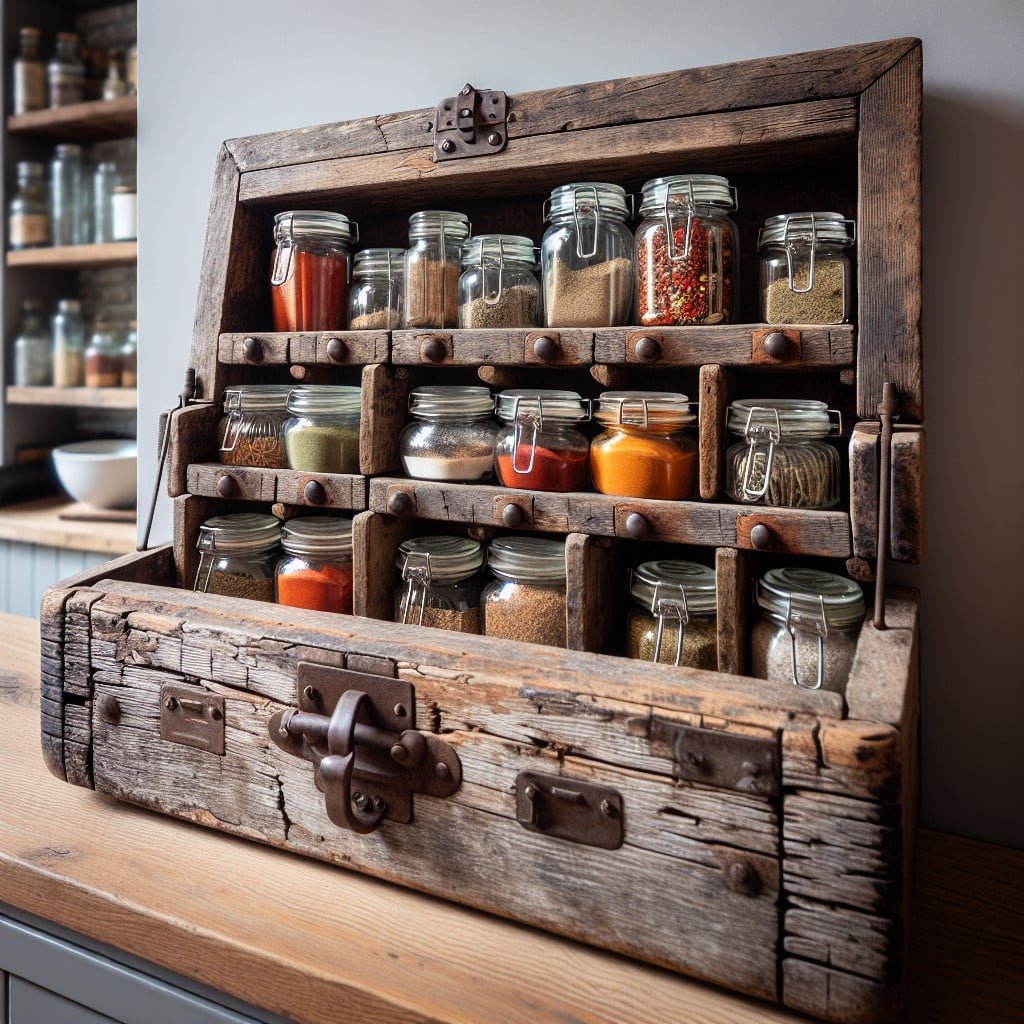
When it comes to repurposing old items, an aged wooden toolbox makes a splendid spice holder. To showcase those herbs and spices, a little creativity along with a touch of sandpaper goes a long way.
1. Prepping the Toolbox:
Clean the toolbox thoroughly and sand it lightly to give a soft and rustic charm. Leave some imperfections as it adds character to the rack.
2. Shelf Adaption:
Depending on the size of the toolbox and your spice jars, you might need to construct or adapt shelves. Wooden dowels or small thin boards work perfectly.
3. Backing:
If the toolbox doesn’t come with a solid back, add one using a thin piece of plywood or salvaged wood to prevent spices from falling out the back.
4. Mounting:
Securely mount the toolbox onto the kitchen wall. It’s essential to use sturdy brackets that can handle the weight, especially if you have a lot of glass jars to store.
5. Personalizing:
Paint labels onto the shelf edges or utilize small tags to define spaces for each herb or spice. It helps maintain organization and gives a quaint, personalized touch.
Remember, the inherent value of this rustic spice rack comes from its unique patina and history, evoking feelings of nostalgia and comfort every time you reach for your favorite spice!
Aged Wood and Leather Spice Rack
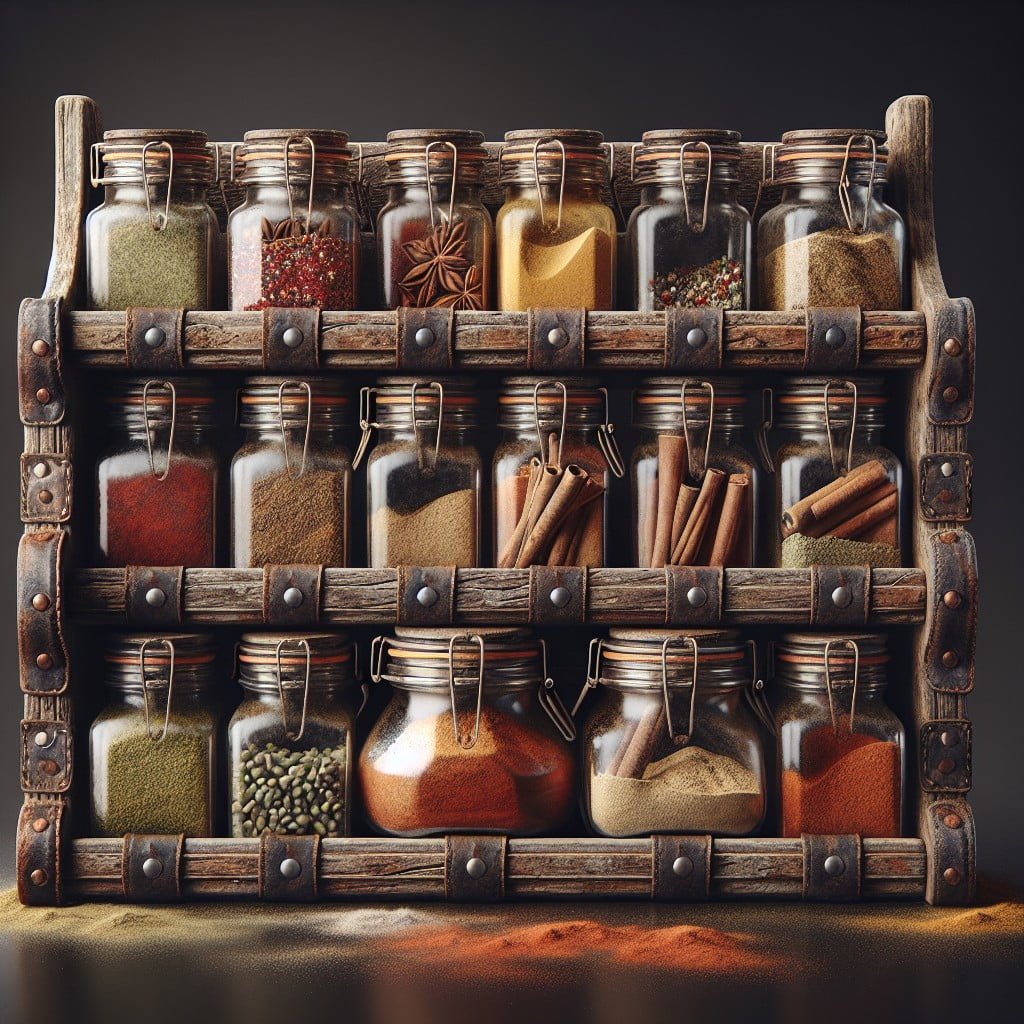
For this exclusive design, begin by sourcing aged or weathered wood that carries unique character marks. This is the main stage for your spices. In stark contrast to the worn wood, choose top-grain, raw-edged leather for straps. These straps serve both aesthetically and functionally by securing the spice jars while adding an elegance that complements the rustic wood.
Creating the spice rack:
- Gather tools and materials. Trim the wood to your preferred size, ensuring it’s capable of holding your spice container size.
- Shape the leather straps. Cut these into the required lengths to accurately surround your spice containers.
- Attach leather straps. Create snug loops around each spice jar. Affix each end of the loop to the wooden base using brass tacks or small screws, ensuring they’re secure.
With this design, an industrial ambiance merges seamlessly with natural elements, creating a bold, distinctive piece. Consider aligning the spice jars in ascending or descending order by size for a visually pleasing effect. This aged wood and leather spice rack is as much a decor addition as it is a functional kitchen accessory.
Industrial Pipe and Wood Spice Rack
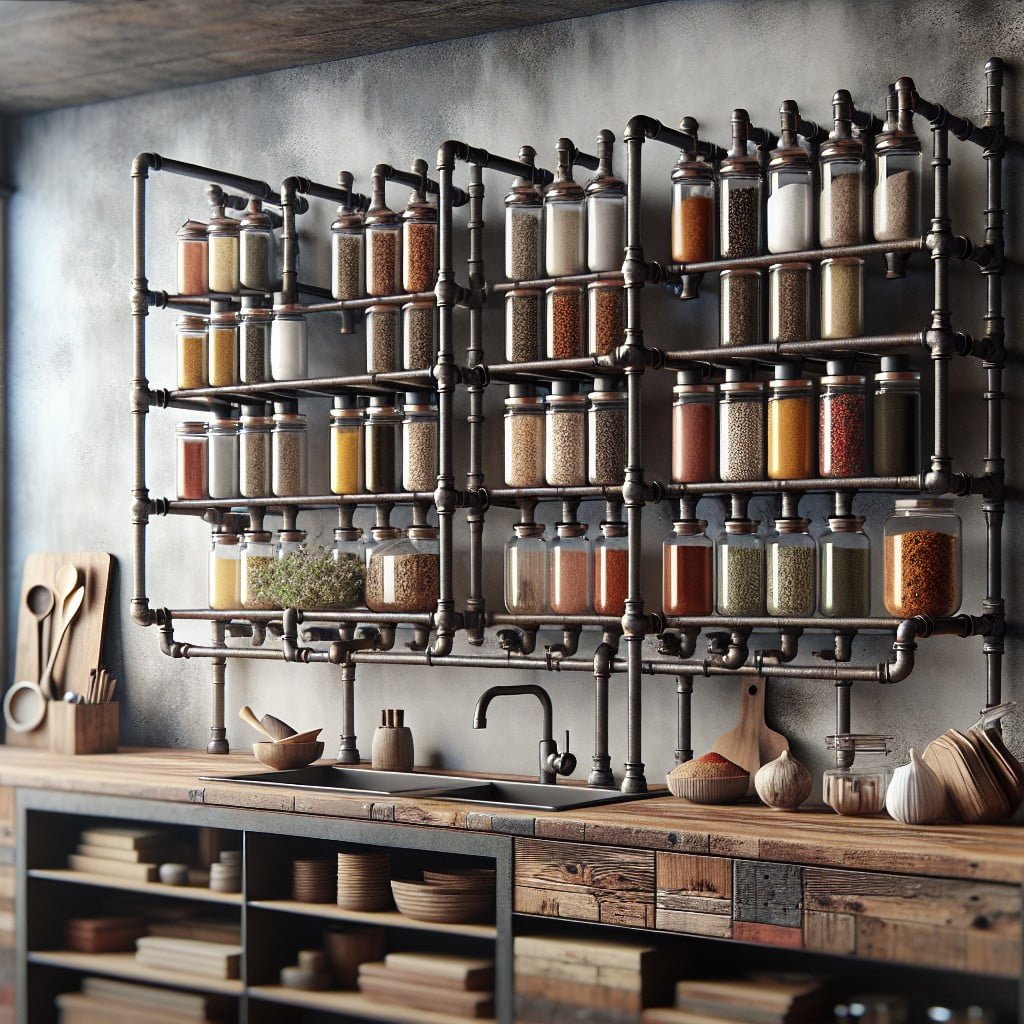
For a chic and robust look, consider blending the bold appeal of industrial pipe with the warmth of wood. This unconventional idea is a great way to add an edgy yet homely twist to your kitchen.
Here are the core elements of crafting it yourself:
- Materials: Gather your essentials which may include iron pipe fittings, a plank of choice wood, screws, wood stain, and paint. The plumbing supplies, readily available at any hardware store, convey a mechanical vibe while the wood provides the rustic contrast.
- Design: Plan your layout bearing the size of your spice collection and available wall space in mind. A typical design includes several shelves supported by the pipe sections. Tiered arrangements can offer stellar visual interest.
- Assembly: Attach the pipes to the wood plank as brackets and secure them using screws. Drill pilot holes to ensure neat addition of screws.
- Finish: Treat the wood with a stain that complements your kitchen’s color palette. Polishing the pipes occasionally can prevent rust or discoloration.
- Placement: Install it on a wall near your cooking area for easy accessibility or against a backdrop of exposed brick for maximum effect.
This unique design cleverly utilizes industrial elements to create functional kitchen decor. It not only keeps your herbs and spices organized but also offers a visually pleasing addition to your rustic kitchen decor.
Reclaimed Window Frame Spice Rack
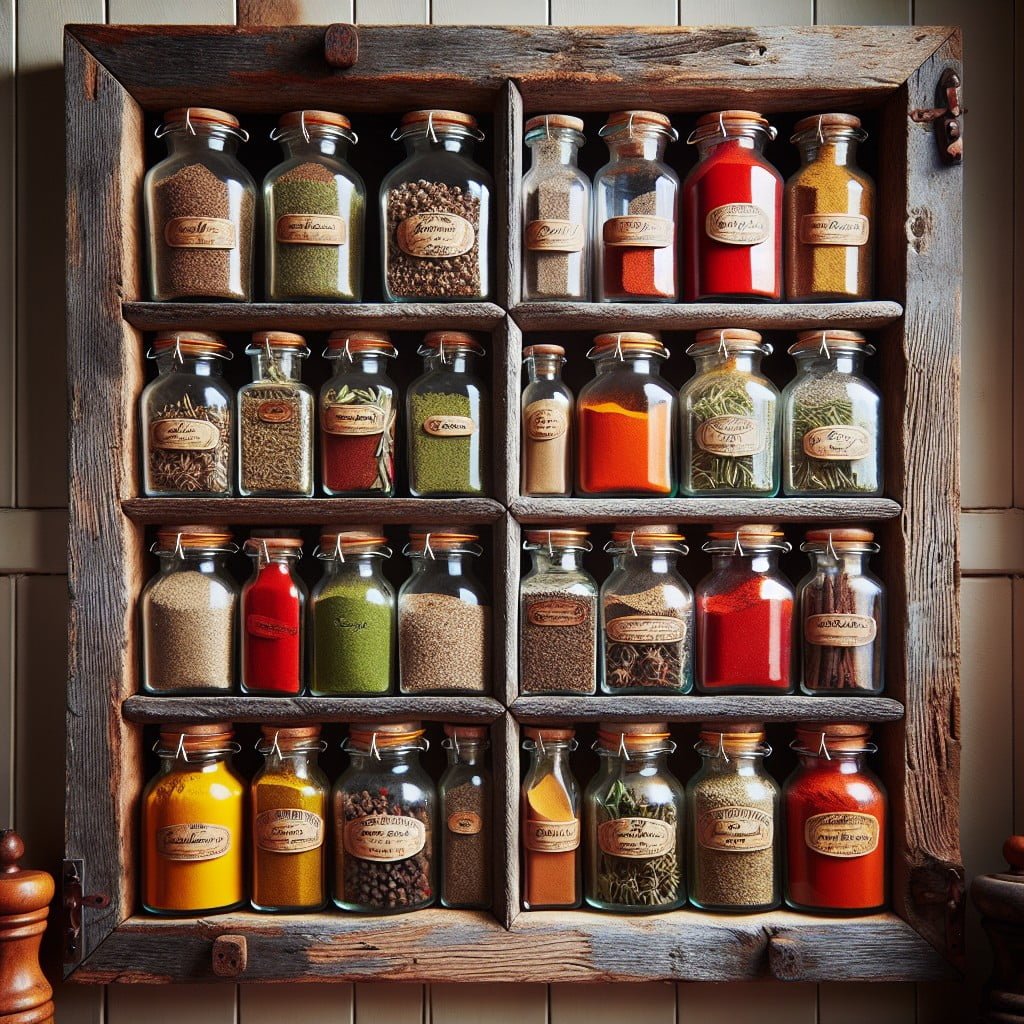
Embracing the charm of a reclaimed window frame as your spice rack extends the rustic vibe in your kitchen. Its transparent panes don’t hide but exhibit your colorful spices, adding style and convenience at the same time.
To create one, follow these simple steps:
1. Choose a window frame: The ideal piece is sturdy yet chic, with multiple glass panes for a visual treat.
2. Add shelves: Install petite wooden shelves in each pane, ensuring they are level and secure.
3. Secure it to the wall: Find a free space on your kitchen wall and hang your rack. Ensure it’s within reach yet safe from stove heat.
4. Label your spices: Clearly label containers for easy identification. Consider matching lid colors to spice types for an extra touch.
Now, your new spice rack doubles as a beautiful display that embraces the rustic aesthetics.
Outdoor Rustic Spice Rack
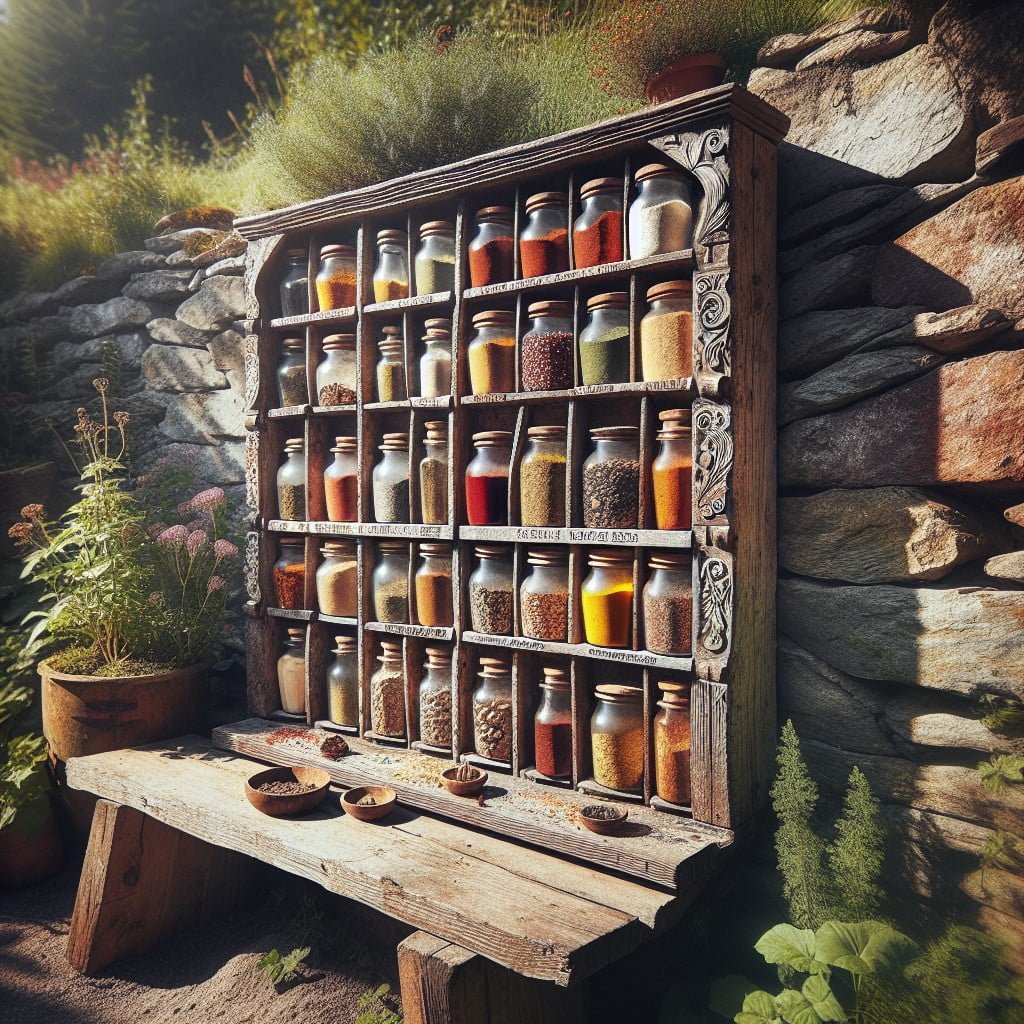
Differentiating your exterior cooking space with an outdoor spice rack offers not only a practical solution but also a tasteful aesthetic touch.
Opt for durable materials like treated wood or rust-resistant metal to withstand various weather conditions.
A rotating carousel-style rack provides easy access, while a wall-mounted rack can save valuable counter space, perfect for small outdoor kitchens.
Adding clear labels on the spice jars can ensure you grab the right flavor even when in a hurry.
Sealed spice jars can keep your spices fresh and safe from outdoor elements.
Consider placing the rack under an outdoor kitchen cabinet for additional protection from direct sunlight or rain.
Finally, ensure your spices are organized in a way that suits your cooking style for a smooth outdoor cooking experience.
Shadow Box Spice Storage
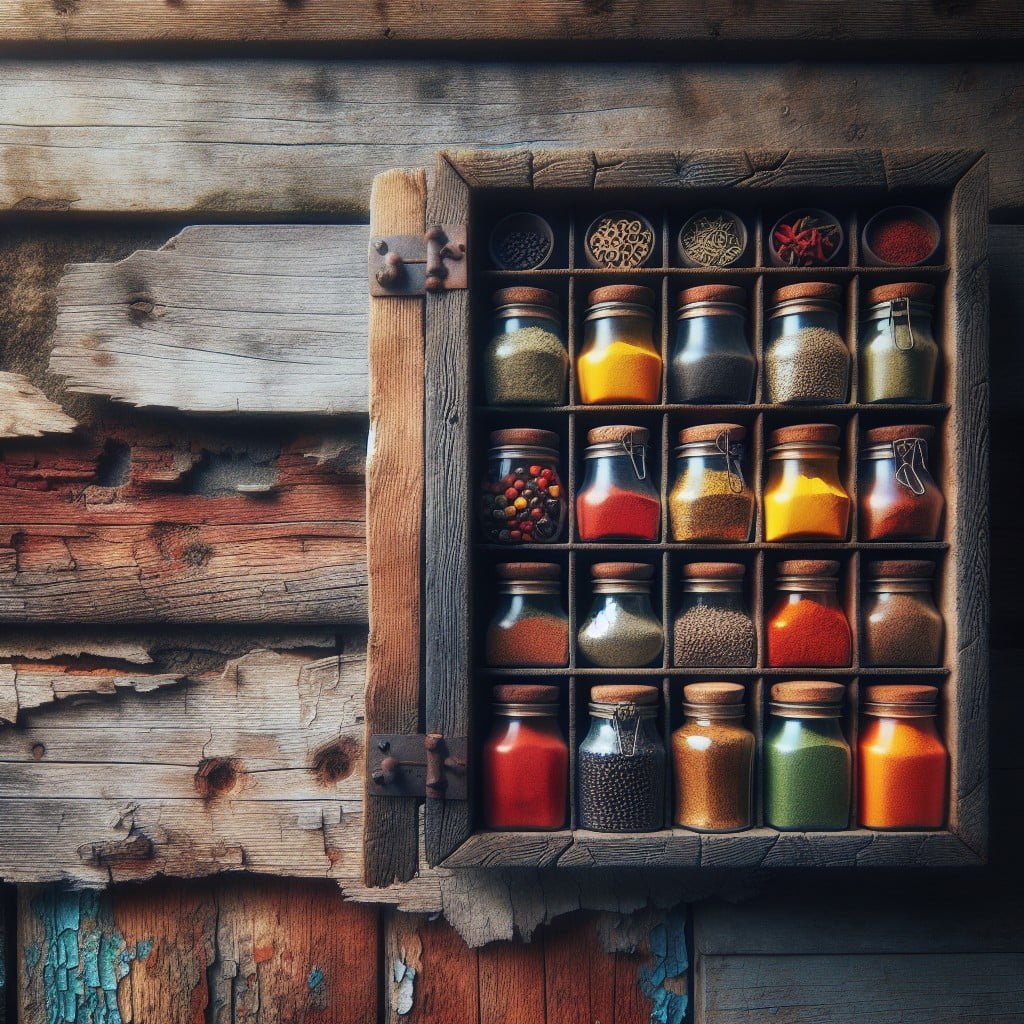
To create this unique spice storage, begin by choosing a sturdy shadow box. Determine the depth you need based on the sizes of your spice containers. Plan the layout of your interior shelves, giving enough space for the containers to fit comfortably. Keep in mind the visual appeal, as the transparent front of the shadow box will display your spices beautifully.
A wood type that complements your kitchen’s aesthetic works best. Whether that’s reclaimed wood for a more vintage look or polished fine wood for a sleek finish depends entirely on your preference. After securing the shelves, attach the acrylic or glass front panel.
The result is both functional and visually stunning, turning your spice collection into a piece of art. This form of storage allows for easy viewing and accessibility, and best of all, it highlights the rich colors and textures of various spices, adding warmth and character to your kitchen.
Rustic Spice Rack From Coffee Mugs
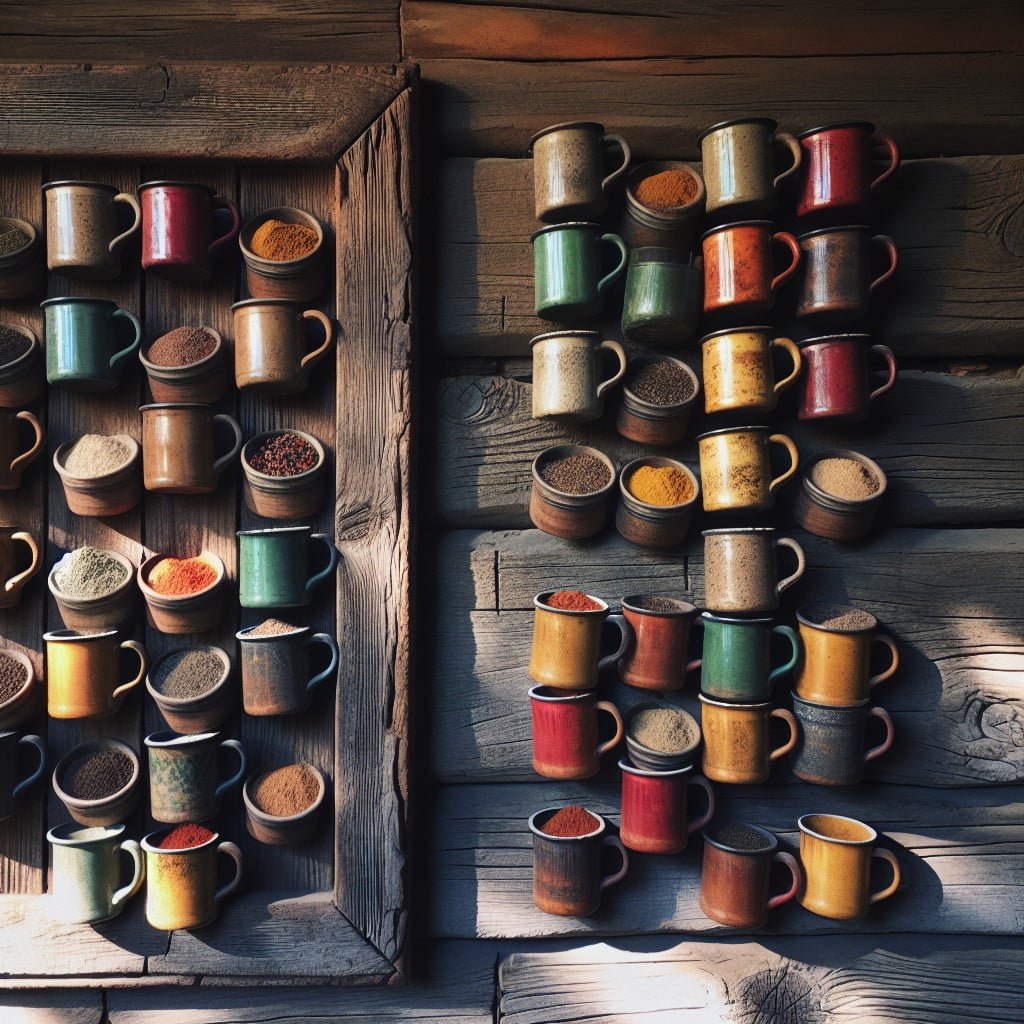
To craft this unique rack, you’ll require some old coffee mugs – the more rustic looking, the better. As well, find a sturdy, untreated farmhouse wood plank, which will be used as the base or backing of your spice rack.
After sourcing your materials, your first step is to attach hooks to the wood plank. Try to space them evenly for aesthetic balance. Now, hang each of your coffee mugs from these hooks, using their handles. The end result? A creative, eye-catching spice rack that’s easy to access and adds instant charm to your kitchen.
Fill each coffee mug with your most-used spices. Transparent lid containers can be used to keep the spices fresh while allowing you to easily identify each one. Small, lightweight measuring spoons could also be hung from the hooks for added functionality. Optional: add labels to the bottom of each mug for quick recognition of the spices.
Remember, this flexible rack setup allows for easy rearrangement as per your needs. So, go ahead and create a rustic, functional spice gallery right within your own kitchen.
Remember the secret ingredients for a successful DIY project: a dash of creativity, a sprinkle of patience, and a whole lot of fun! So get the hammer and nails out, and let the spice magic begin!
Miniature Wooden Crate Spice Organizer
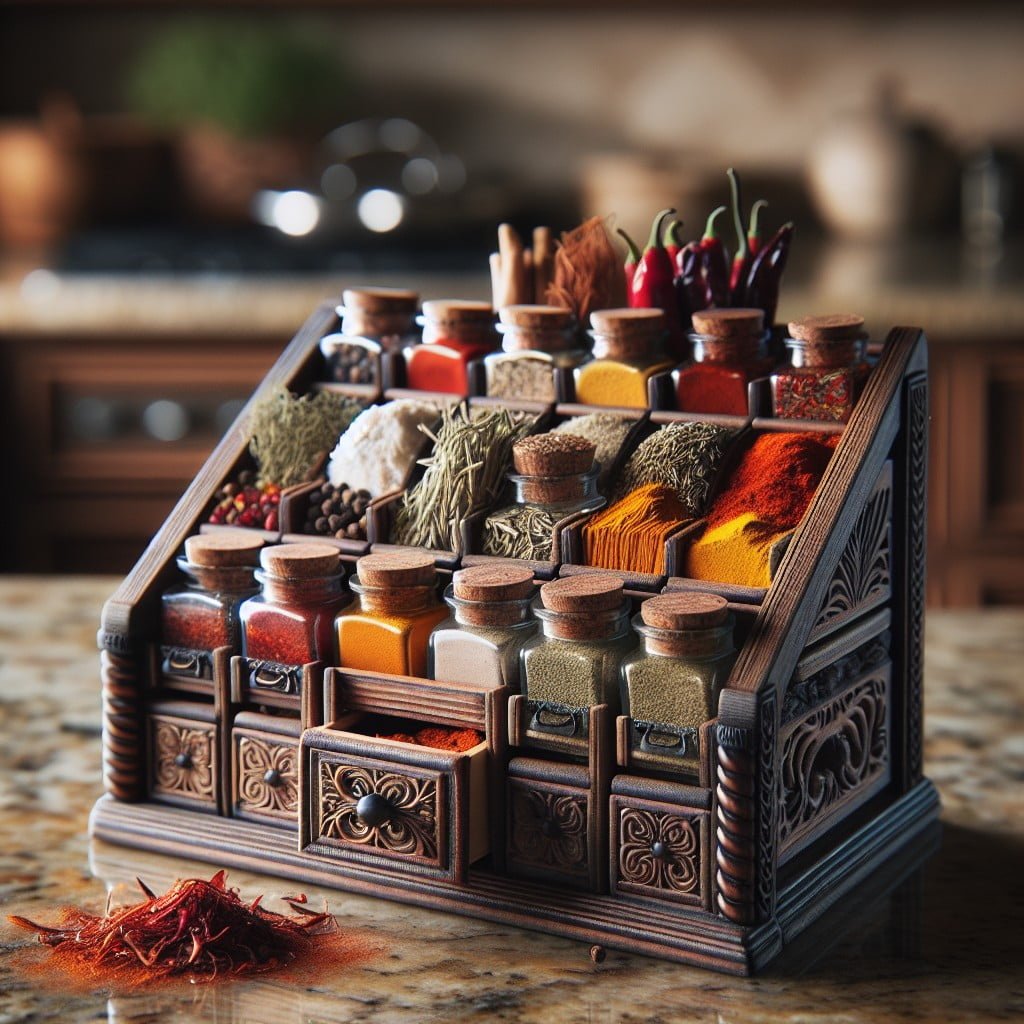
Cutesy and practical, this rustic style organizer mirrors classic farmside charm that will give a homey touch to your kitchen.
Here’s how you can create it:
1. Start by sourcing miniature wooden crates. They can easily be found online, at local craft stores, or in flea markets for a genuine rustic touch.
2. Depending on the dimensions of the containers, you might have to adjust the number of crates accordingly. For small seasoning jars, a 6×4 crate works well.
3. Opt for those with open slats. This doesn’t just add to the aesthetic but makes it easier to spot the seasoning you need.
4. Arrange your crates horizontally or vertically to suit your wall space. You can stack them or keep them separate.
5. Then, mount these crates on the wall using brackets or strong adhesive wall hooks, considering their weight when filled.
6. Fill your crates with spice jars. Glass jars are a tasteful choice due to their transparent nature, allowing easy identification of the spices.
Not only can this organizer adequately hold your spices, but it can also add a warm and cozy element to the interior décor of your kitchen.
Ideas Elsewhere
- https://foter.com/wood-wall-spice-rack
- https://www.theinspiredhive.com/2016/07/ikea-hack-rustic-farmhouse-spice-rack.html
- https://www.realsimple.com/13-diy-spice-rack-ideas-for-an-organized-kitchen-7555721
Recap:
